Posts Tagged the henry ford magazine
Model (i) Educator
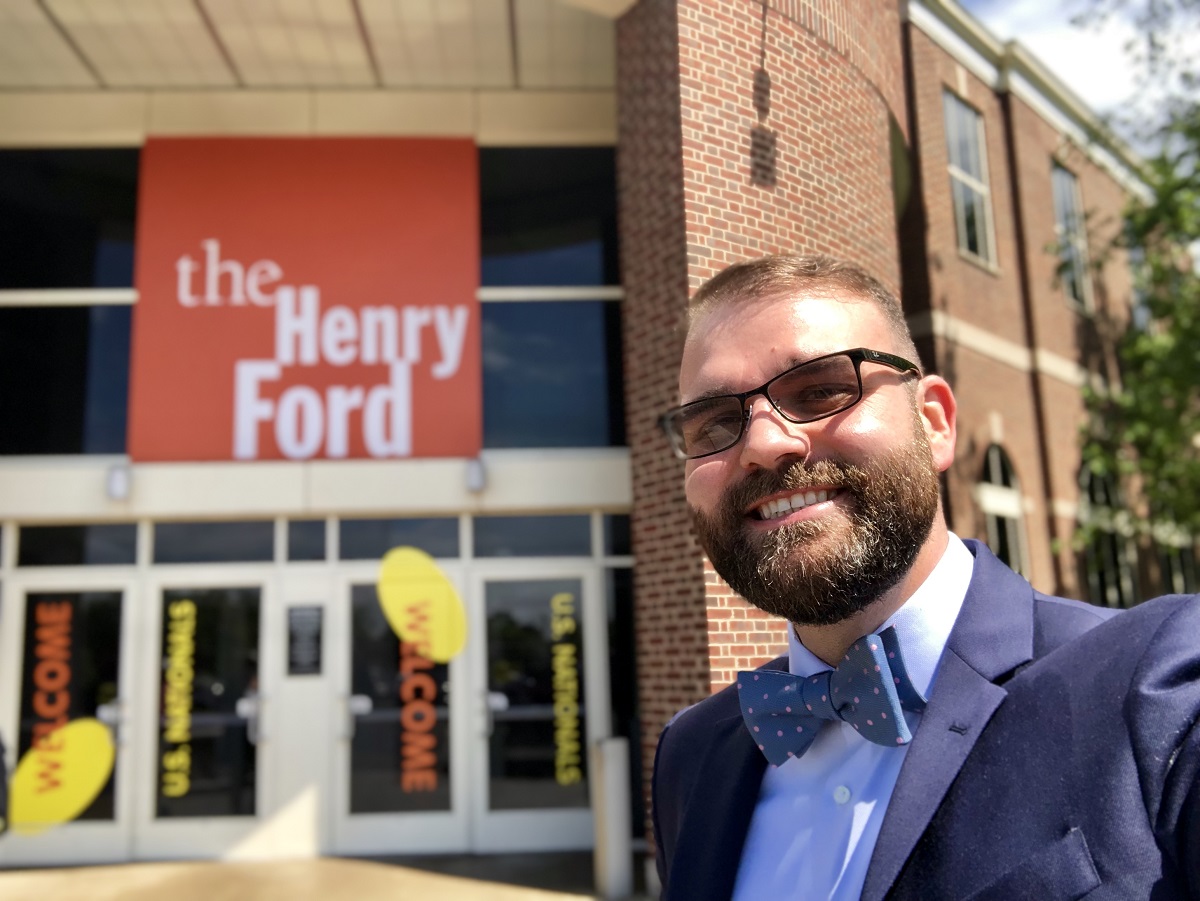
Teacher and Model i practitioner Spencer Kiper.
For years, The Henry Ford has been committed to providing unique learning resources and experiences for educators, drawing on lessons from our past to inspire the next generation. At the core of these learning resources is Model i, a unique learning framework which provides an interdisciplinary language and approach for teaching innovation learning based on the Actions of Innovation and Habits of an Innovator.
When Spencer Kiper, a middle school teacher in Bossier City, Louisiana, traveled to Dearborn in 2017 to receive The Henry Ford’s 2017 Teacher Innovator Award, Model i might have been in its infancy, but Kiper was hooked and put it into action in his classroom.
Designed to spark an innovative mindset, The Henry Ford’s Model i framework promotes something even more fundamental: a sense of what it’s like to walk in someone else’s shoes. “Understanding the perspective of others, or the struggles or strifes of groups of people, that is something we don’t spend a great deal of time doing in education,” said Kiper, who was also the 2019 Louisiana State Teacher of the Year. “With Model i, this is the first thing you do. From the get-go, it inspires a very different kind of feel in the classroom.”
Connecting schools to The Henry Ford’s collections, Model i intrigued Kiper during his 2017 visit to The Henry Ford. He’d been looking for ways to fuel design-inspired thinking and problem-solving skills in his middle school STEM students—a framework that could generate fresh, insightful solutions and streamline coursework. At the time, Model i was in its early stages, much of its substance not yet finalized. That didn’t deter Kiper from dropping basic Model i concepts into his classroom.
“One of the biggest hurdles I face as a teacher is overcoming that ‘I can’t do this because I’m not creative’ mentality,” said Kiper, who believes Model i is a roadmap back to creativity that hasn’t been nurtured over time. “By starting with small problems, you allow students to ease their toe back into being creative and see little wins, little successes. And then you introduce them to the big problems. That’s a pretty big dividend.”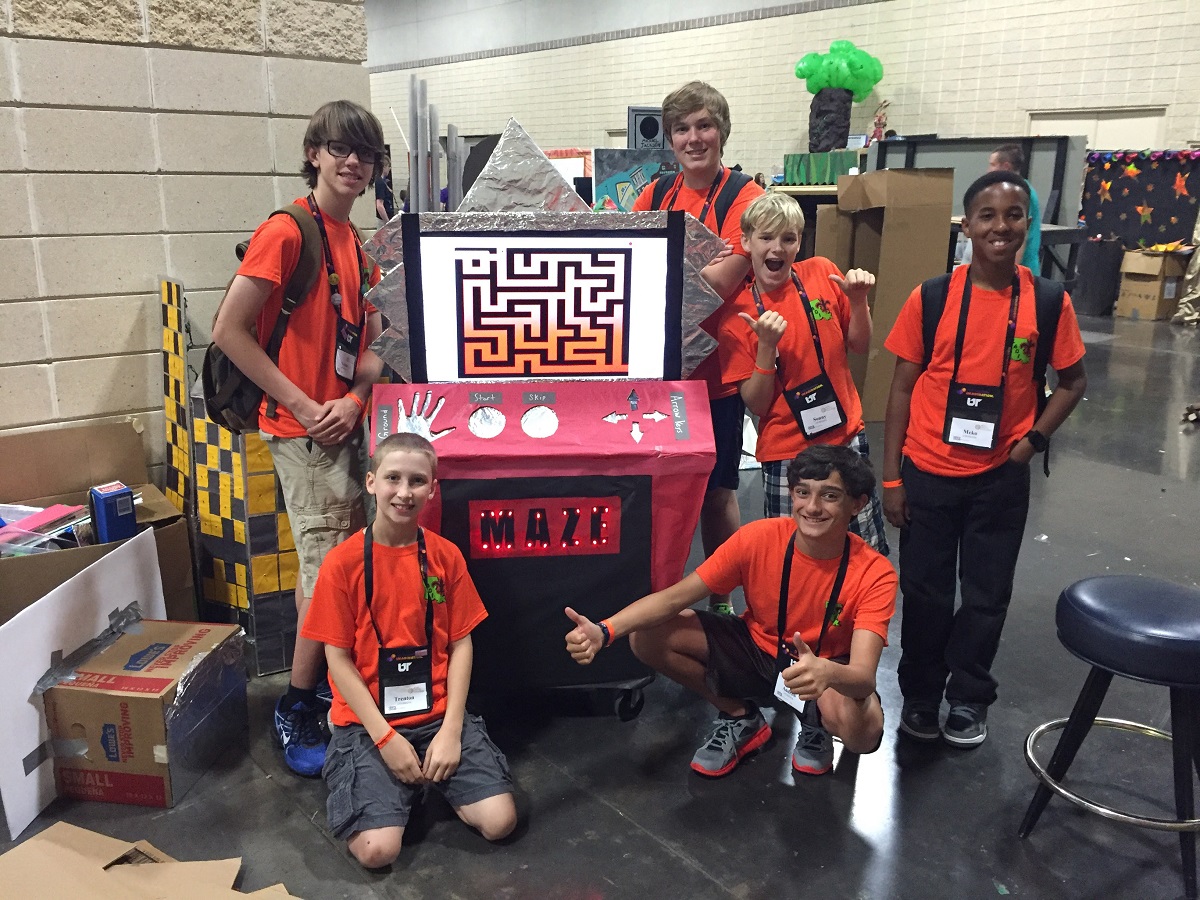
Spencer Kiper’s Destination Imagination team constructed a working cardboard arcade to compete against teams from around the world at a recent Destination Imagination global final.
According to Phil Grumm, senior manager of learning services and on-site programs at The Henry Ford, educators like Kiper have become pseudo co-authors of the ever-evolving framework. “When you put Model i into the hands of an expert teacher and superuser like Spencer, he finds his own connections and relevance, and deploys it in creative and innovative ways we never intended nor anticipated.”
For Kiper and his students, Model i was a natural fit with STEM on Screen, a film festival/mini invention convention Kiper had created to bring industry leaders to students to give real-world feedback on their world-enhancing innovations. It also found applications in his Campus 2 Campus Connection with Centenary College of Louisiana, which gave pre-med biology students the opportunity to strengthen empathy skills by mentoring Kiper’s STEM class. “Studying our artifacts and stories shows us that empathy is a critical habit for innovators to practice and develop to not only solve relevant problems but identify them in the first place,” said Grumm.
Kiper likes to praise Model i’s focus on de-stigmatizing failure and explaining why mistakes must be baked into every creative process. Embedding failure into learning also makes teachers better prepared to teach, which is why Kiper, who was recently named instructional technologist for Caddo Parish, Louisiana, readily employs Model i in his teacher education courses. “As an ideological concept, it can be placed in any sort of educational context and see success,” he said. “It’s a fun and engaging way of learning that’s going to stay with you for the long haul.”
In June of 2021, The Henry Ford launched the inHub website to provide educators around the world with access to The Henry Ford's innovation learning resources. Educators can sign up for a free inHub membership to receive unlimited access to all of The Henry Ford's learning resources, in addition to professional development opportunities. Become an inHub member for free today to get started.
This post was adapted from an article by Susan Zweig in the June–December 2020 issue of The Henry Ford Magazine.
Michigan, Dearborn, 21st century, 2010s, The Henry Ford Magazine, teachers and teaching, Teacher Innovator Awards, Model i, innovation learning, education, by Susan Zweig
Sustainable and Inclusive Design: What We’re Reading
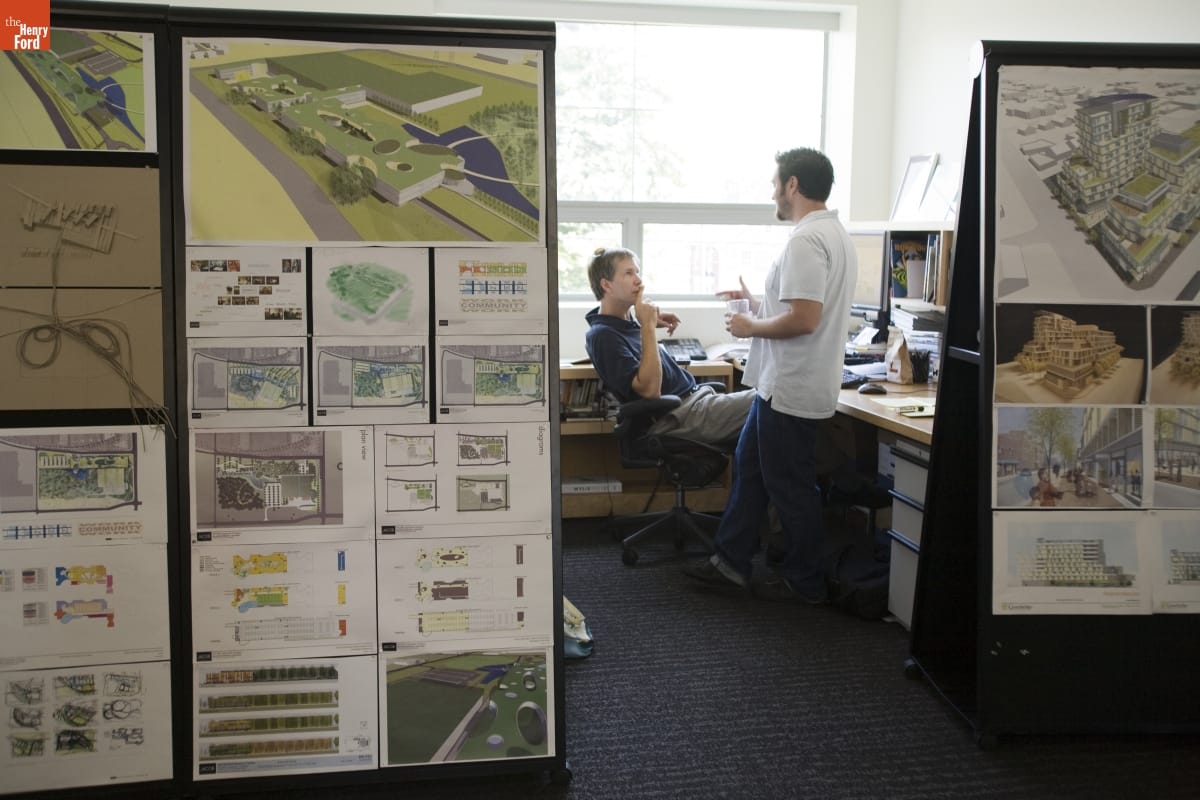
Photograph of the offices of William McDonough, sustainable design architect, taken in September 2008 by Michelle Andonian. / THF56407
In every issue of The Henry Ford Magazine, our staff provide reading, listening, and viewing recommendations. In the June-December 2020 issue, we focused on books (and one resolution) that touch on sustainable and/or inclusive design. See what you think of our selections below.
Resolution 70/1—Transforming Our World: The 2030 Agenda for Sustainable Development by the United Nations (UN)
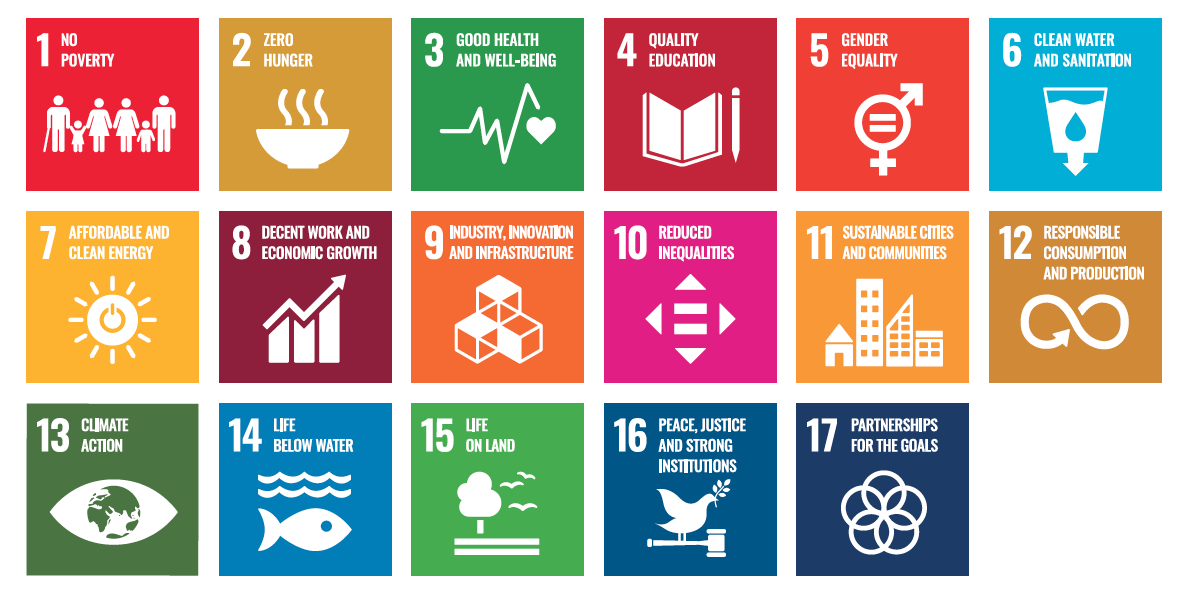
Resolution 70/1 identifies goals essential to the survival of people and the planet. / SDG icons courtesy of the United Nations Department of Public Information
Read this living document that lays out 17 sustainable development goals aimed at mobilizing global efforts to end poverty, foster peace, safeguard the rights and dignity of all people, and protect the planet.
At the heart of sustainable design lies the concept of sustainable development—that the needs of the present should not compromise the resources essential for the future. Sustainable design manages resources with the goal of ensuring their survival for yet unknown needs. This seems essential if the planet is to sustain life in the future.
Yet the idea of sustainable design remains debatable. How do you “value” the sacrifice for future generations? Without quantification, this amounts to a tough sell when others argue in favor of financial gain realized through business practices that exploit natural resources, contribute to the global climate crisis, or line the pockets of a few but leave the majority impoverished.
The United Nations’ call to action, Resolution 70/1—Transforming Our World: The 2030 Agenda for Sustainable Development, identifies 17 goals around which independent nations can plan and implement actions unique to their cultures and resources. The target date, 2030 (now only 10 years away), becomes even more sobering when you consider the high stakes.
-- Debra Reid, Curator of Agriculture and the Environment
Micro Living: 40 Innovative Tiny Houses Equipped for Full-Time Living, in 400 Square Feet or Less by Derek “Deek” Diedricksen
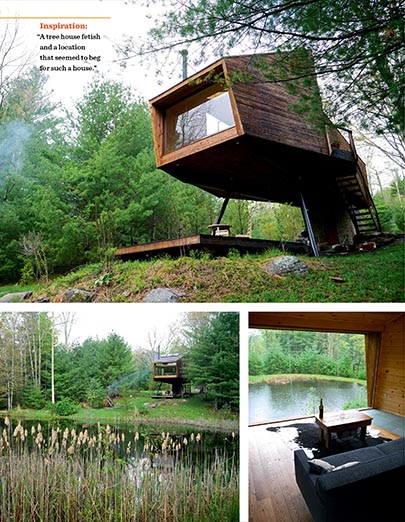
Images courtesy of Micro Living: 40 Innovative Tiny Houses Equipped for Full-Time Living, in 400 Square Feet or Less and Derek “Deek” Diedricksen
This picture-filled paperback shows the range of tiny houses around the United States and rates them by livability. Deek Diedricksen is a connoisseur of tiny houses. For anyone with even a modest interest in sustainable architecture, this is a fun read, even just to browse through the pictures and floor plans.
--Charles Sable, Curator of Decorative Arts
El Deafo by Cece Bell
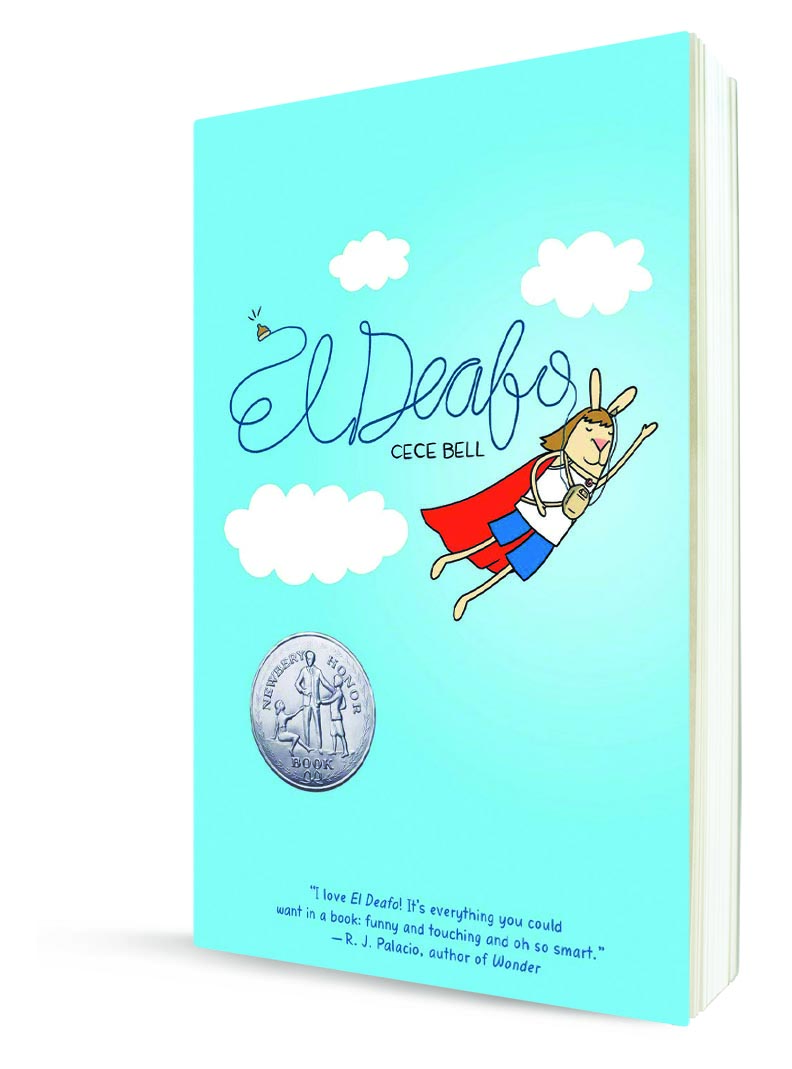
As an accessibility specialist, I am always looking for books that convey the mindset of people with disabilities. El Deafo is such a book. In this graphic novel, author Cece Bell tells her story of growing up deaf and how she was able to channel her differences to feel like she had superpowers.
This captivating book will leave you thinking about the meaningfulness of acceptance long after you finish it.
--Caroline Braden, Accessibility Specialist
At Day’s Close: Night in Times Past by A. Roger Ekirch
Working alongside some of the world’s most important artifacts related to power and energy, I think often about humanity’s motivations to tame the natural world. The desire to bring light to darkness is an innovation with vast consequences, both environmentally and, as A. Roger Ekirch points out, socially.
His At Day’s Close is an exhaustive look at the social history of darkness and an opportunity for the reader to reflect on possible motivations for the push to illuminate the night.
--Meredith Long, Director of Collections Operations
Books from Our Library Collection
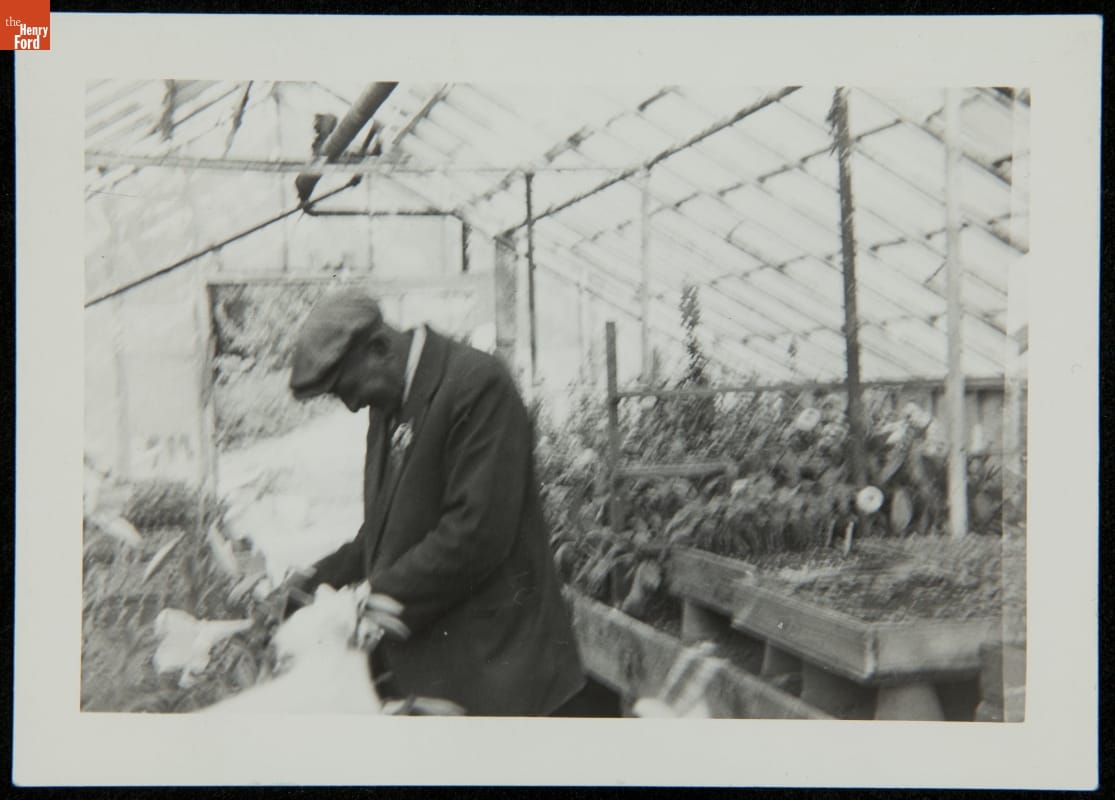
George Washington Carver in a Greenhouse, 1939 / THF213726
Searching for more resources on sustainable design and those innovators past and present who practice it? The Benson Ford Research Center can help connect you with artifacts, articles, and everything in-between The Henry Ford has collected with a sustainability-based theme—some books from our library that fit this topic are listed below. For assistance with access, contact the Research Center.
Merchants of Virtue: Herman Miller and the Making of a Sustainable Company by Bill Birchard
Aluminum Upcycled: Sustainable Design in Historical Perspective by Carl A. Zimring
Sustainable by Design: Explorations in Theory and Practice by Stuart Walker
Why Design Now? National Design Triennial by Cara McCarty, Ellen Lupton, Matilda McQuaid, Cynthia Smith, Andrea Lipps (contributor)
Design with the Other 90%: Cities by Cynthia E. Smith
Textile Visionaries: Innovation and Sustainability in Textile Design by Bradley Quinn
My Work Is That of Conservation: An Environmental Biography of George Washington Carver by Mark D. Hersey
Something New Under the Sun: An Environmental History of the Twentieth-Century World by J.R. McNeill
This post was adapted from an article first published in the June–December 2020 issue of The Henry Ford Magazine.
Every year, The Henry Ford partners with the Industrial Designers Society of America (IDSA) on their International Design Excellence Awards (IDEA). The Henry Ford receives and processes the entries, and then hosts dozens of jurors—including The Henry Ford’s own Vice President of Historical Resources and Chief Curator Marc Greuther. Those products that win become part of the permanent collections of The Henry Ford.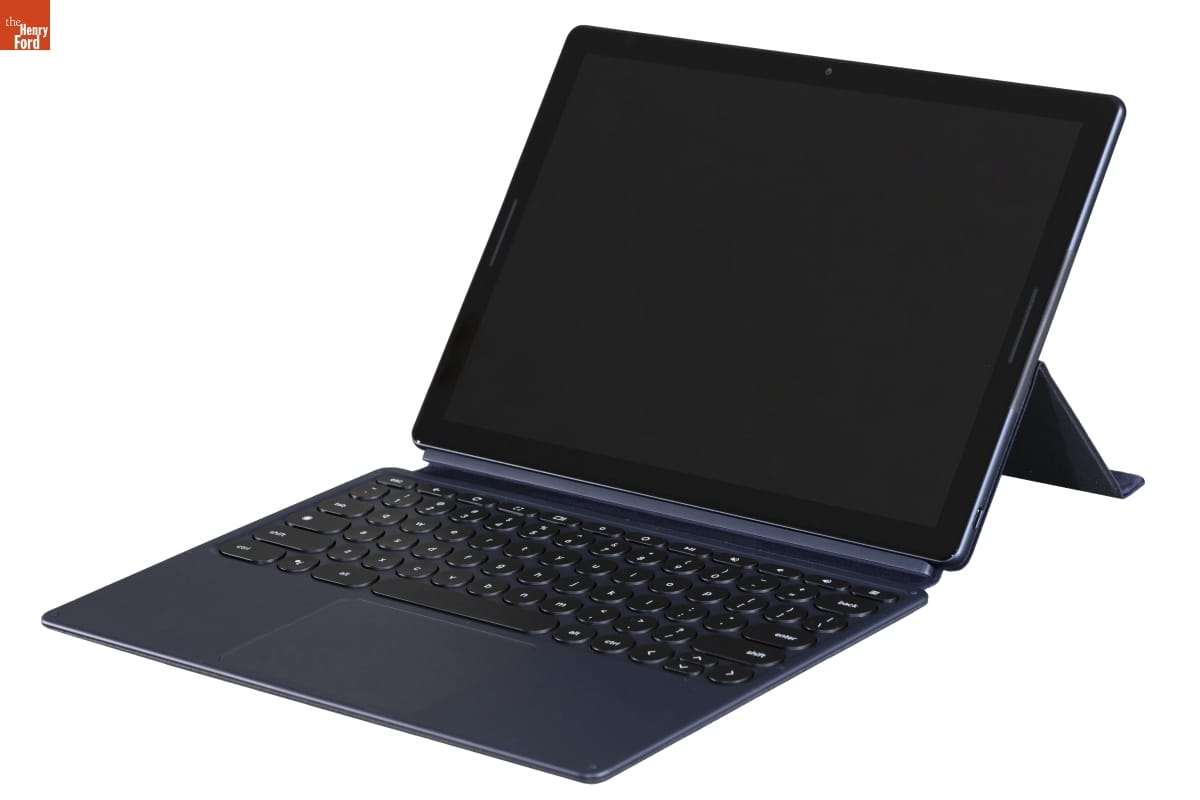
Google Pixel Slate, IDEA bronze award winner in the consumer technology category, 2019. / THF185319
While asking Greuther and IDSA Executive Director Chris Livaudais about the relationship between the two institutions, we also took the opportunity to ask them about the judging process. In addition, Greuther shared the rationale behind some of his “Curator’s Choice” award picks from previous years.
Do you think the concerns of the IDEA jury have shifted over the years? If so, how?
Chris Livaudais: The IDEA jury rotates each year, but it is always composed of designers who are at the top of their field. In many cases, their work is what drives our profession forward and sets the bench other designers follow. As such, the interests of the jury do tend to shift with current trends or conversations within the industry. Sustainability and circular design are huge areas of interest right now, for example. To counter this, IDEA uses the same core judging criteria [see box below] each year. This consistency helps keep things rigorous, while still providing a little room for interpretation and influence from current forces impacting design.
| IDEA Judging Criteria |
| Design Innovation: How new is the product or service? What critical problem is it solving? How clever is the solution? Does it advance a product category? Benefit to User: How are users’ lives improved through this design? Can they accomplish things not previously possible? Benefit to Client/Brand: What is the business impact of this design? How has leveraging design proven to be a key market differentiator? Benefit to Society: Does the solution consider social and cultural factors? Is it designed/manufactured with sustainable methods/materials? Appropriate Aesthetics: Does the form of the design adequately relate to its use/function? Are the colors/materials/finishes used befitting its purpose? |
From your perspective, what are IDSA jurors looking for?
Marc Greuther: I think over time, I’ve seen two distinct lenses that get played out in the jurying process. One is rooted in “good design is good business” and responsibility. So it’s about utility, user interface, user experience. It’s about effectiveness, about durability. It’s about the use of appropriate materials.
The other has got much more to do with industrial design as a discipline and a certain kind of design purity, and it gets to how well-finished something is. Where are the part lines on there? How do dissimilar materials join in a way that’s pleasing? If you’re in the wrong mindset, you can start looking at it as being incredibly fussy and overly judgmental, but it’s really the design discipline’s roots in craft.
NordicPul: all-weather women's work gloves, IDEA bronze award winner in the student designs category, 2010. / THF154924
Part of what IDSA’s done well is put together a jury that has a wide range of backgrounds. People who know about assistive technology, the medical arena, gamers, and all the rest of it. That’s part of the secret of its effectiveness—ensuring that such a wide range has got a presence.
How do you approach the Curator’s Choice?
Marc Greuther: I’ve never tried to take it on as a kind of contrarian, but I’ve definitely seen things where I’ve felt like, “Holy cow, that’s been disregarded or knocked out of the spotlight for pretty poor reasons, and it needs to be rendered visible.”
I have the great advantage of not having to ask permission for the ones I award. I just try to ensure that my winners are thinking about the use of good materials and the appropriate deployment of objects: their sustainability, their usability, their understandability. It’s an interesting motley crew of things.
IDEA Curator’s Choice Award Selections
Hydropack Self-Hydrating Drink Pouch
Photo courtesy Hydration Technology Innovations LLC
Year: 2011
Description: Water-filtering pouch that becomes a flavored drink rich in electrolytes
Designed by: HTI Water
Why Greuther picked it: “This was for use in disaster situations to purify water. It hadn’t been given the recognition I thought it deserved. There were some designers who said it wasn’t designed. That, to me, was of interest, because sometimes you don’t need to design any more. Why? It was that notion of design almost getting out of the way. It’s about exercising restraint. Less is better in this instance.”
EzyStove
Photo courtesy of McKinsey Design
Year: 2012
Description: Wood-burning stove for use in developing countries as a replacement for cooking over an open fire
Designed by: Ergonomidesign, Mårten Andrén, Håkan Bergkvist, Jonas Dolk, August Michael, Stefan Strandberg and Elisabeth Ramel-Wåhrberg for Creative Entrepreneur Solutions
Why Greuther picked it: “This was about cleaner, more efficient use of existing resources in places where people would be improvising all manner of ways of cooking or heating. It wasn’t trying to be the complete solution. It was partially reliant on charity and the local skills of the users. I liked that it seemed hackable and that people could bootleg this thing. It was about effecting change.”
Sonos SUB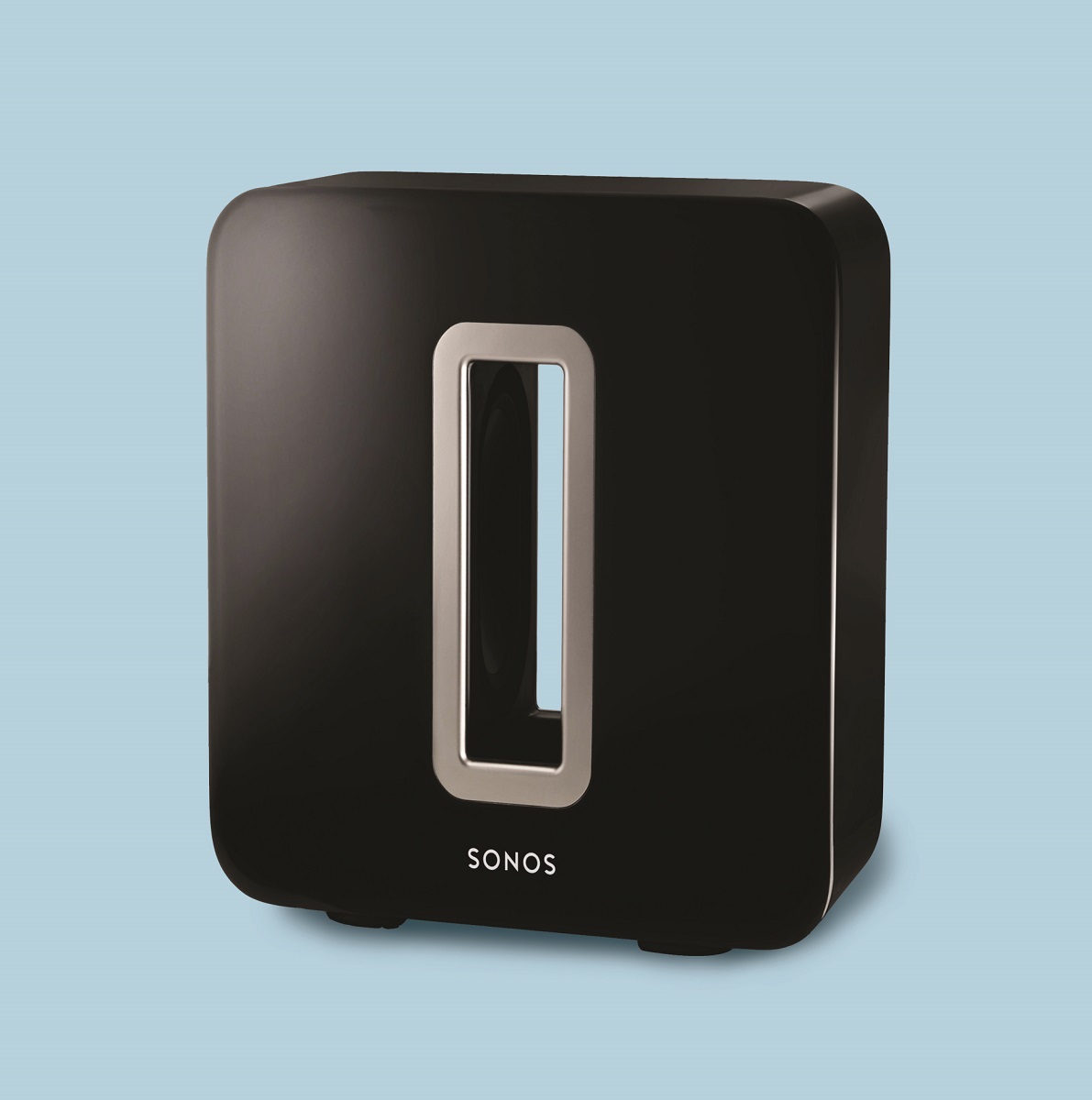
Photo by Dave Lauridsen
Year: 2013
Description: Wireless subwoofer
Designed by: Mieko Kusano and Rob Lambourne of Sonos Inc., and Wai-Loong Lim of Y Studios LLC for Sonos Inc.
Why Greuther picked it: “Sonos had committed themselves to backwards compatibility, and they were building things that had enough redundancy in them that new functionality could play out in them. The SUB sounds really good. It’s a very enigmatic looking thing, and it was designed to work with their earliest equipment. It’s got kind of a Kubrick-like quality to it.”
Pillpack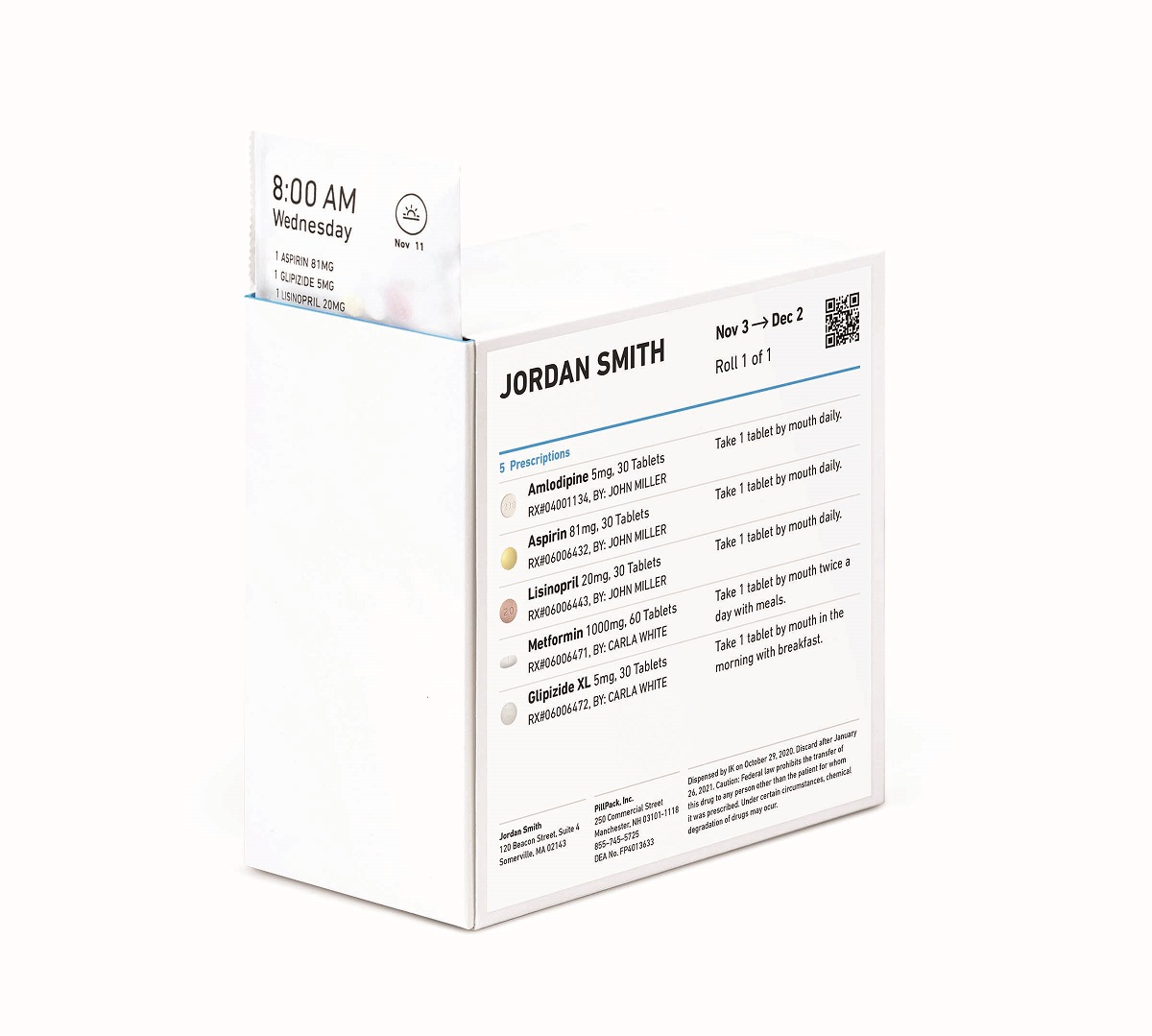
Photo courtesy of Pillpack
Year: 2014
Description: Delivery and management service for people with multiple medications
Designed by: TJ Parker and Elliot Cohen of PillPack, and Jennifer Sarich-Harvey, Sophy Lee, Katherine Londergan and Gen Suzuki of IDEO
Why Greuther picked it: “This is rooted in my sense that as medications have proliferated as conditions become treatable in one way or another, the complexities of managing those medications almost exponentially increase, and the chances of missing a dose or peculiar interactions increase as well. This was a way of managing that complexity. It’s almost infrastructural.”
Flip Reel by Squiddies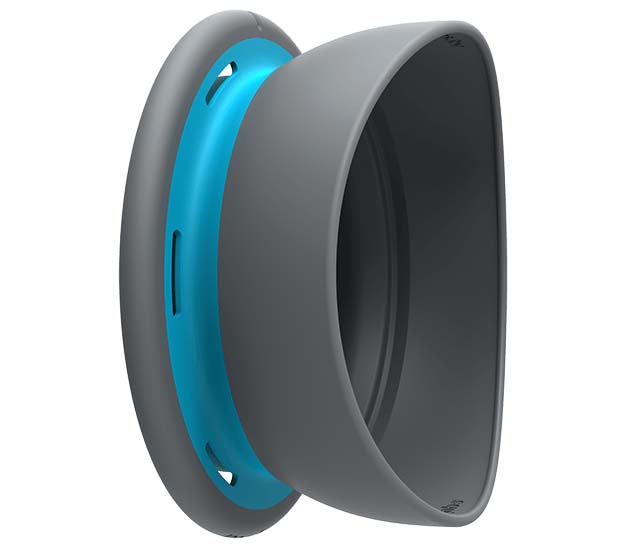
Photo courtesy of Tiller Design
Year: 2015
Description: Handline fishing reel
Designed by: Brandon Liew, Robert Tiller and Lisa Gyecsek of Tiller Design for Squiddies Pty. Ltd.
Why Greuther picked it: “This was an interesting use of new materials. It was very minimal. The irony for me is that I don’t fish. I’ve never fished. I never intend to. But I did like the idea that this was something that could be easily pocketed, casually used. I like that notion of design that just slips into its place, because it’s so usable and so readily apparent in its usage.”
SNOO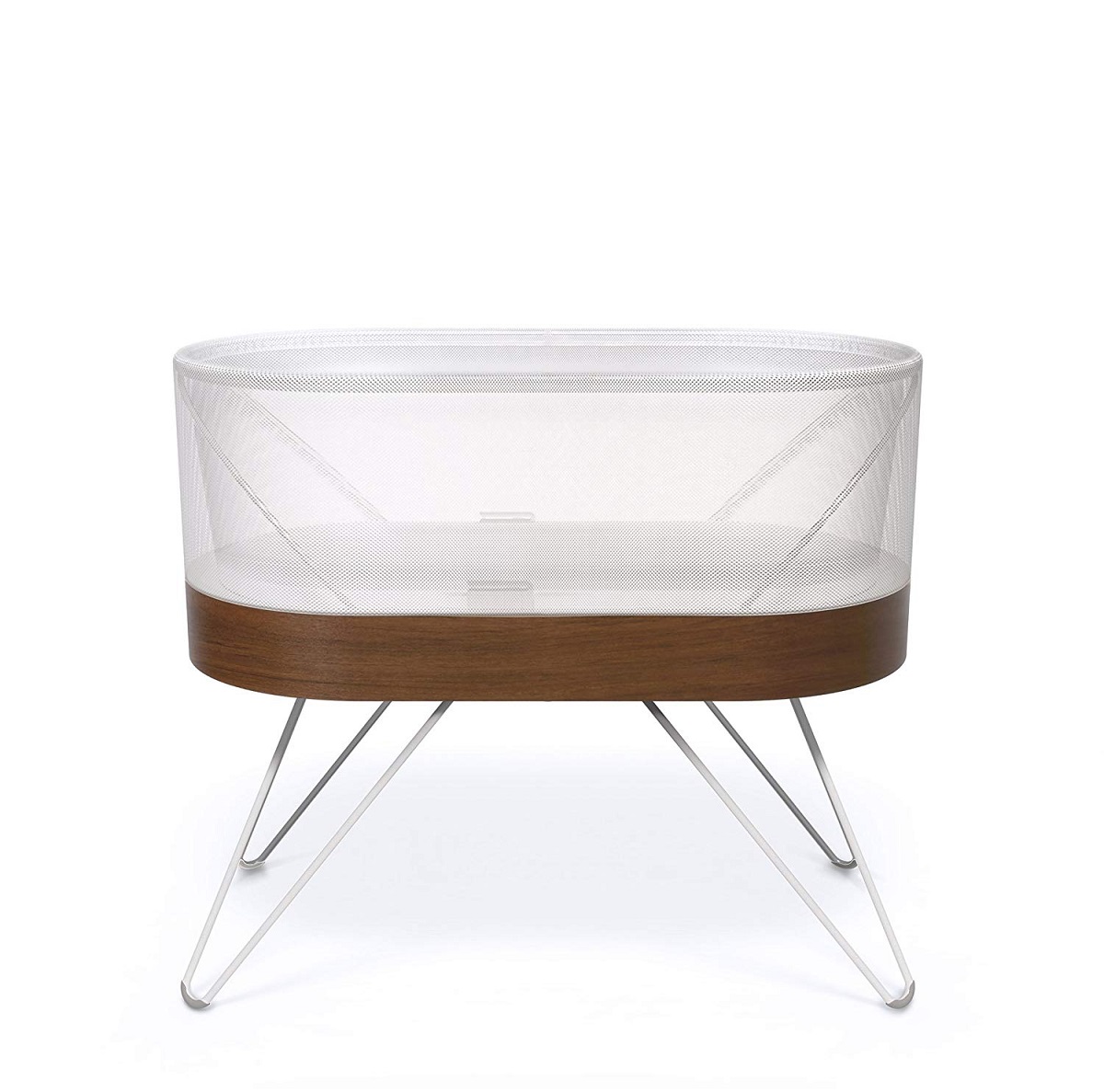
Photo by Travis Rathbone
Year: 2018
Description: Robotic bassinet
Designed by: Yves Béhar, Qin Li, Michelle Dawson and fuseproject design team, and Dr. Harvey Karp of Happiest Baby
Why Greuther picked it: “It’s a beautiful object. Part of what I liked about it was that it was robotic. When you look at robotics from a cultural standpoint, it’s almost always very threatening. This is robotic technology, but it’s designed to take care of newborns, something incredibly vulnerable, so the robotic element is appropriately stated and deeply camouflaged. I thought that was an interesting kind of paradox.”
Bernie Brooks is Collections Specialist at The Henry Ford. This post was adapted from an article first published in the June–December 2020 issue of The Henry Ford Magazine.
International Design Excellence Awards, #Behind The Scenes @ The Henry Ford, The Henry Ford Magazine, by Bernie Brooks, design
Lens of Optimism: The Henry Ford and the Industrial Designers Society of America
Every year in the spring, the boxes begin to arrive from all over the world. Just a few at first…. Then more and more, day after day. They are carted from the loading dock down a long hallway and into The Henry Ford’s Main Storage Building. There, they will fill dozens of shelves and tables. In each, a product: computers and smartphones, sporting goods and medical supplies, appliances and tools, all manner of things solving all manner of problems.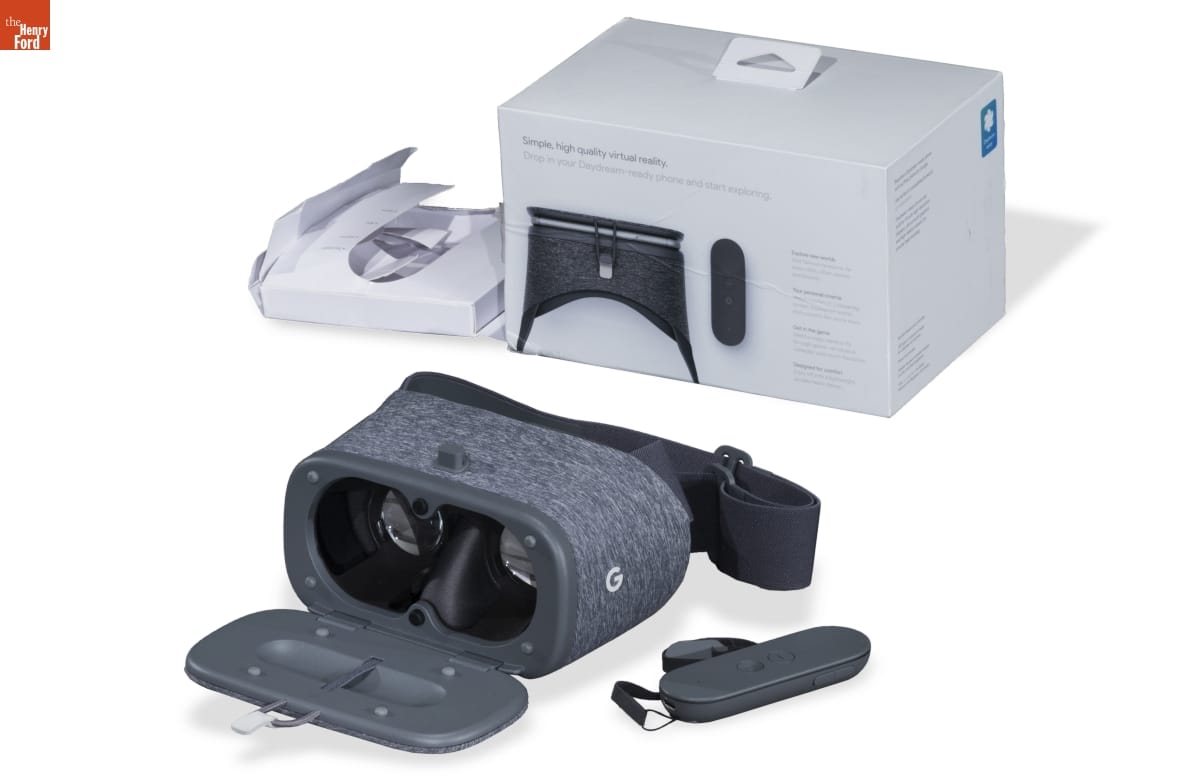
Google "Daydream View" virtual reality headset, IDEA gold award winner in the consumer technology category, 2017. / THF174007
These are finalists in the Industrial Designers Society of America’s International Design Excellence Awards (known as IDSA and IDEA, respectively). Over the next several weeks, museum staff will process and sort them into 19 categories ranging from Automotive & Transportation and Service Design to Social Impact. Eventually, 41 esteemed jurors—representing a microcosm of the wide-ranging practices and interests of the industrial design community—descend upon the entries. The best will be declared winners and accessioned into The Henry Ford’s permanent collection, as they have been since 2010.
This ongoing partnership was the result of a 2009 meeting former Chief Historian Christian Øverland and current Vice President of Historical Resources and Chief Curator Marc Greuther from The Henry Ford took with Clive Roux, IDSA’s executive director at the time. At the meeting, Øverland and Greuther pitched the idea that there could be a relationship between The Henry Ford and IDSA based on the latter’s yearly IDEA judging process. The storied professional association agreed. Greuther was asked to select the recipient of a Curator’s Choice Award each year and was eventually given a spot on the jury.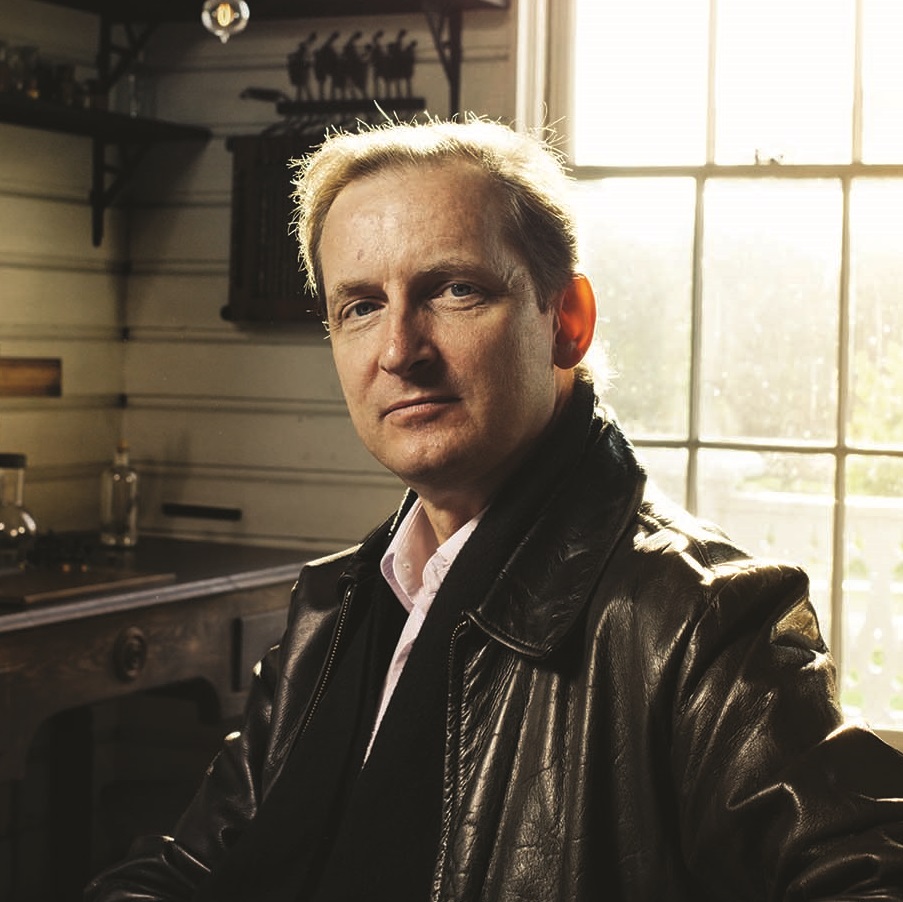
The Henry Ford’s Vice President of Historical Resources and Chief Curator Marc Greuther. / Photo by Roy Ritchie.
Below, Marc Greuther and IDSA’s current executive director, Chris Livaudais, answer some questions. We talked to Greuther about The Henry Ford’s relationship with IDSA, IDEA, and curating through the eyes of designers. Livaudais provides his own perspective on IDSA’s partnership with The Henry Ford, how IDSA helps to promote sustainability in industrial design, and more.
IDSA’s Executive Director Chris Livaudais.
Why did The Henry Ford’s relationship with IDSA come about?
Marc Greuther: It partly came about because of a deeper institutional interest in design. That heightened a lot in the ‘80s under [former president of The Henry Ford] Harold Skramstad, who’d done work with the Eames Office. There was a deeper sense that The Henry Ford had good design holdings that got to the origins of the industrial design profession—and we wanted to continue building those collections.
I think a lot of how I’d looked at it at the time related to the proliferation of designers and design in everyday life. I wanted to ensure that we could stay current but also work more closely with designers, partly to get their take on things but also to make them aware of us as a resource. Unlike many museums, we didn’t just collect spectacular things to put on a plinth. We were quite eager to collect prototypical material and process-related material. It could be drawings, sketches, false starts, dead ends. We were aware that designers could look at that and it would be useful.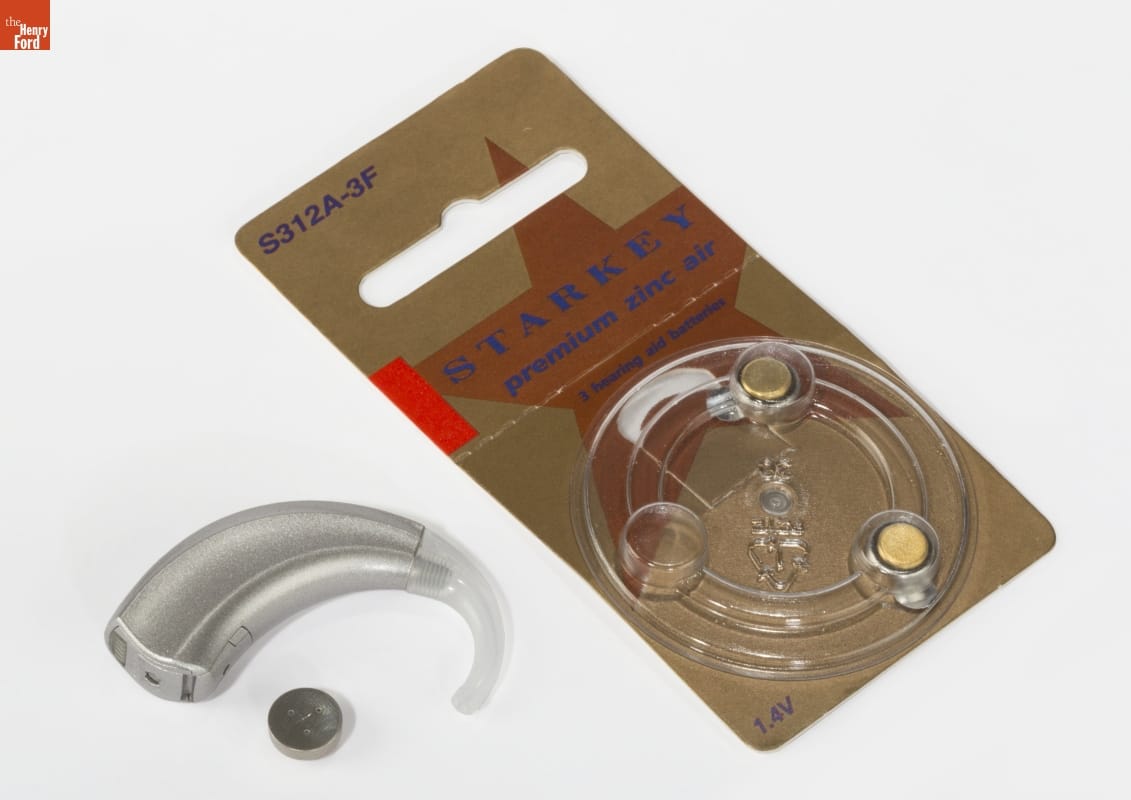
Starkey Laboratories S Series behind-the-ear hearing aid, IDEA silver award winner in the medical & scientific products category, 2010. / THF166375
It was based on real mutual benefit. Because design is a discipline that touches people’s lives, IDSA was interested in being more visible, so their work was better understood. Industrial design for many companies was still seen as a styling exercise. But the design discipline had evolved to a point where, no, there’s human factors—the benefits of technologies can be rendered in more usable ways if people’s needs are being better anticipated. Designers are intermediaries for those kinds of processes.
How has the partnership with The Henry Ford benefited IDSA?
Chris Livaudais: IDEA [celebrated] its 40-year anniversary [in 2020], making it one of the oldest design awards competitions around. Our collaboration with The Henry Ford provides an additional level of credibility to the program and helps preserve the legacy of design’s impact on our society. All winning IDEA products can be entered into the museum’s permanent collection, so this is a unique and huge incentive for designers to enter their work into the competition.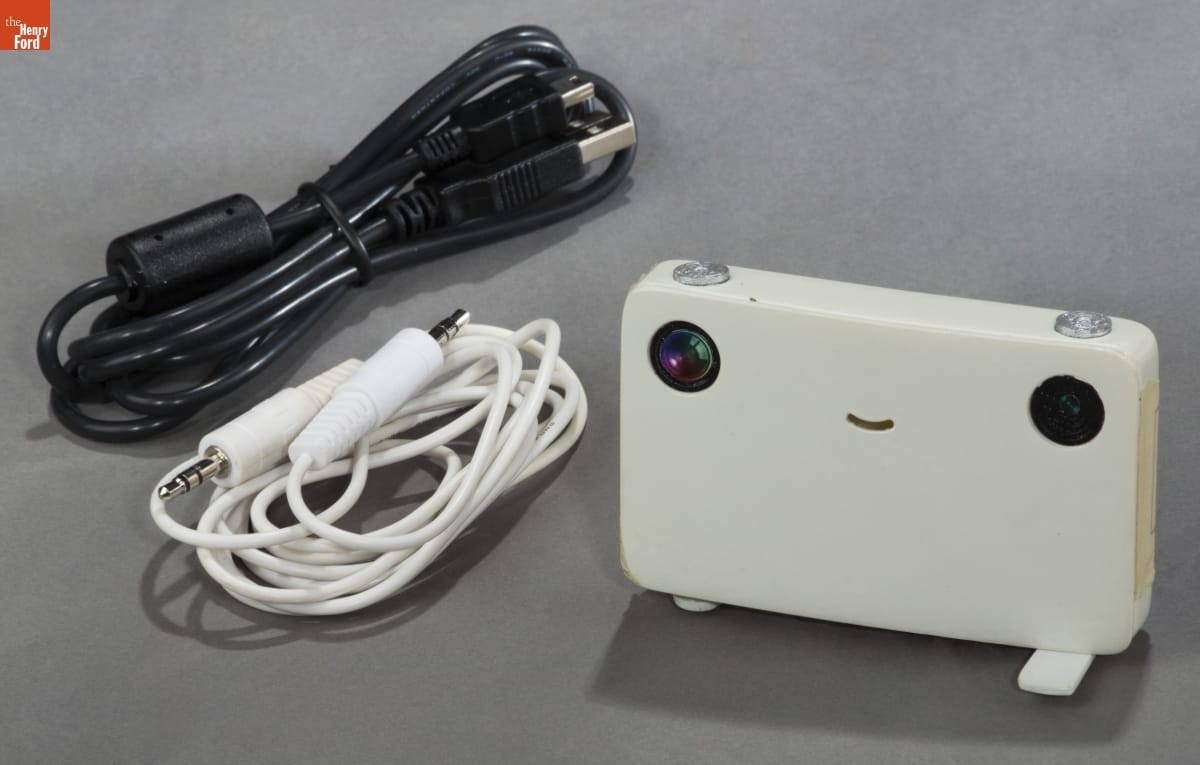
Model of "Pico - The Projector Camera," IDEA bronze award winner in the student designs category, 2010. / THF171351
How does the IDSA collaboration relate to and benefit The Henry Ford’s mission and collections?
Marc Greuther: We’ve been able to acquire items that we might not necessarily know about—because of the markets they serve—or even be able to encounter. I think if we can build our collections in a literal sense, we’re always going to be able to get things out in front of the public that serve our mission to inspire people through America’s traditions of ingenuity, resourcefulness, and innovation.
The vast majority of the designers we’ve met are interested in the design discipline as a way of making the world a better place. And that’s a good subtext for our mission. We’re not simply trying to document new or novel things; we’re looking at the deployment of human creativity and imagination.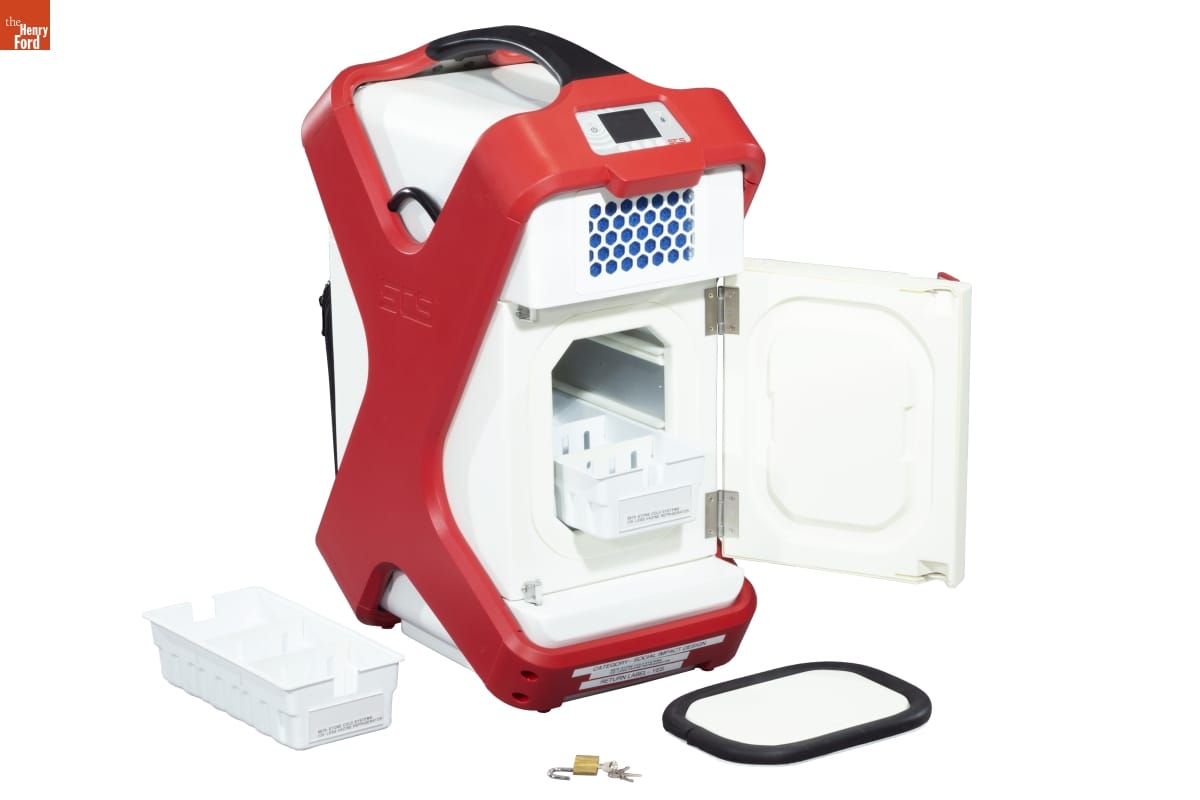
Stone Cold Systems ice-less vaccine refrigerator, IDEA bronze award winner in the social impact design category, 2018. You can get two curatorial perspectives about this artifact here. / THF185488
One of the jurors once said that one of the things he loves about going to the IDSA conference is that you’re hanging out with optimists. I think that’s another slant on our mission, which is optimistic. It’s that sense that things can be improved. I think that’s one of the best readings of how Henry Ford collected for the institution and how we’ve built off that.
Collecting via IDEA seems to create the potential for incredible contrast between the totally new and untested and the iconic artifacts already in the collection. It allows us to play with that edge, because we’re doing it through an industrial designer’s eyes. That’s why I value some of the earlier smartphones and gadgetry that have come in. You look at it and think, “Wow, I wouldn’t collect that now. That’s such a flash in the pan.” And it’s a good job that I didn’t collect it then with a future perspective of my own, because I would’ve been wrong. But it was the best guess of an industrial designer, and that has value.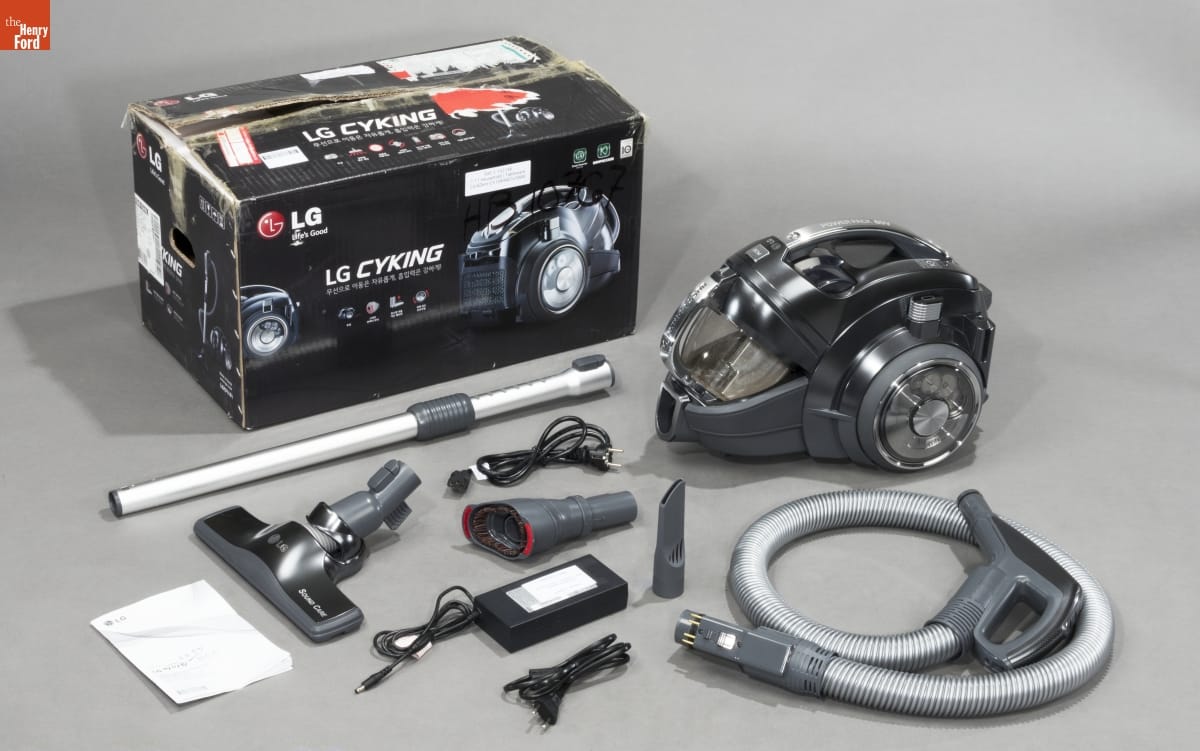
LG Electronics "CordZero C5" cordless canister vacuum cleaner, IDEA bronze award winner in the home & bath category, 2015. / THF176286
One of the first exhibits I enjoyed at The Henry Ford when I first visited in 1986 was called Yesterday’s Tomorrows. It was all about past views of what the future would be like. That applies to some of the IDSA materials we’ve got. It’s that notion of “Journalism is the first draft of history,” right? It’s going to get superseded pretty quick, but it’s still got value. Our IDSA collections are the first draft of an industrial designer’s sense of what’s important.
When you’re talking about an institution that has the kind of collections that The Henry Ford has, the relationship with IDSA is an incredible asset. In 10 years, if one IDEA award winner is a huge success, the museum might have the prototype already.
Marc Greuther: Or we might have the very first production model. It gets to the fact that the institution is obviously very much wanting to see things through a lens of innovation, and innovation takes place across all of our collections, but it’s apparent in some more than others, simply because of the nature of what’s going on technologically in the world.
It is interesting to think about how IDEA has grown collections that seem incredibly workaday. If you think about the impact of ergonomics and human factors research into the design of handles for ladles and traditional kitchen utensils, that grows our collection in those areas that seem utterly everyday. That’s where design is an interesting discipline. New materials come along, or new knowledge about the way the body works or doesn’t work. All the work that’s been done by companies like OXO Good Grips is deeply informed by research into arthritis and rheumatism, and just the sheer inappropriateness of so many everyday utensil designs.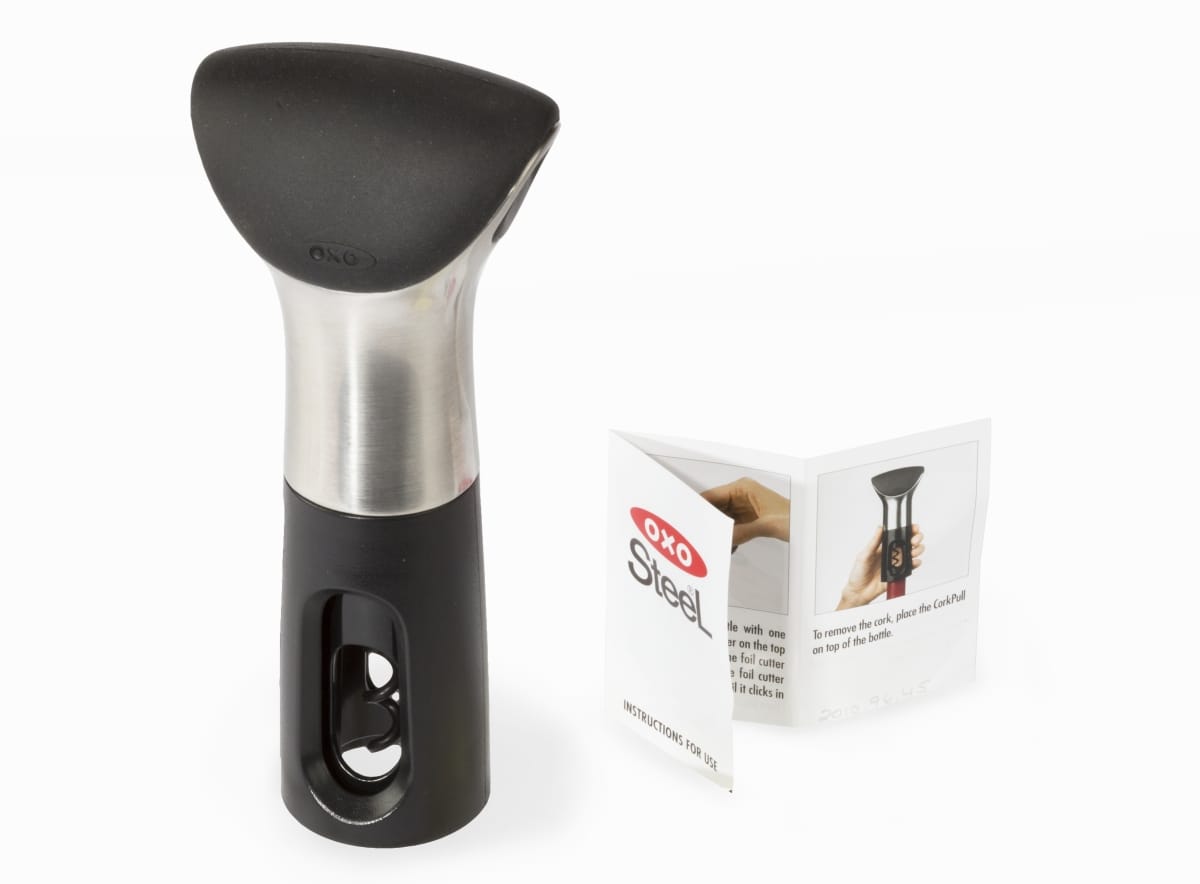
OXO SteeL CorkPull, IDEA bronze award winner in the home furnishings category, 2010. / THF166376
As someone who’s been on the jury for many years now, you get these things that come up—brand-spanking-new, out-of-the-box office concepts—and you’ll look at it and say, “Yeah, OK. I saw that in a Robert Propst drawing from 1962.” It’s good to be able to wield that historical perspective and say, “Hey, you know what? That’s been noticed before, and this is how it played out.”
How does IDSA hope to promote the continued growth of sustainable design practices going forward?
Chris Livaudais: IDSA has long been active in promoting responsible and sustainable design practices to the design community. In 2014, for example, we supported the development and distribution of Okala Practitioner, a comprehensive resource for designers on materials and best practices related to the ecological impact and footprint of a given product or service. We also have an Ecodesign special interest section, which allows subject matter experts in this space to connect and generate content for publication throughout IDSA’s networks. It is very important for us as a professional association to advocate for this topic and to show that having responsibly designed products can in fact be positive for our planet, the people who use the products and the bottom line of the business.
Bernie Brooks is Collections Specialist at The Henry Ford. This post was adapted from an article first published in the June–December 2020 issue of The Henry Ford Magazine.
International Design Excellence Awards, The Henry Ford Magazine, design, by Bernie Brooks, #Behind The Scenes @ The Henry Ford
Rappahannock Oyster Co.: Finding a “Win-Win” for People and Chesapeake Bay

Photo courtesy Rappahannock Oyster Co.
As early as 1920, Chesapeake Bay’s seemingly limitless oyster population had been diminished by up to one-third, both by overharvesting and by habitat destruction caused by siltation and dredging. By 2001, the harmful effects of pollution and disease had taken their toll, and the bay’s native Virginica oysters dwindled to less than 1% of their historic numbers. The bay had all but collapsed.
It was under these conditions that cousins Ryan and Travis Croxton decided to revitalize their family’s historic oyster farm, Rappahannock Oyster Co. Founded in 1899 by their great-grandfather, James Croxton, on Virginia’s Rappahannock River, the company wasn’t much more than mud by the time the cousins took over the leases in 2001. But in that rich tideland, the cousins saw an opportunity to salvage a family legacy and renew their community.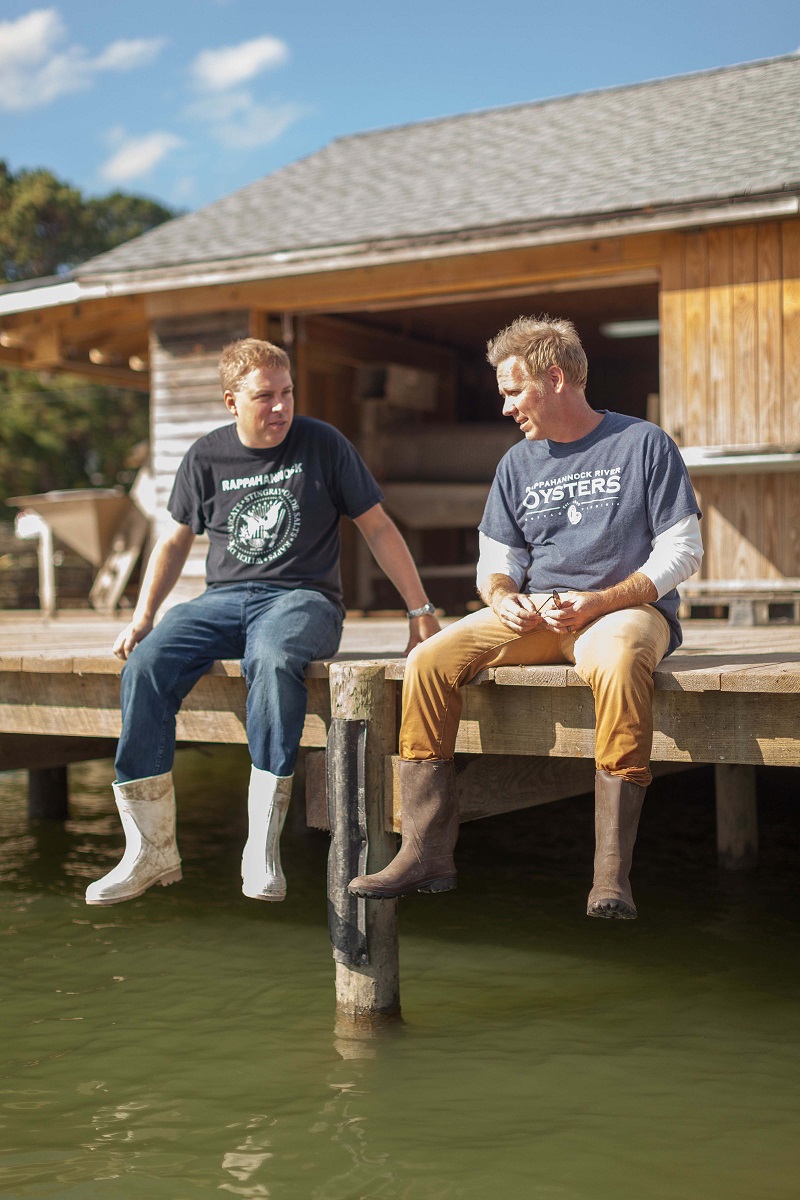
Cousins Travis (left) and Ryan Croxton have transformed their great-grandfather’s oyster farm, Rappahannock Oyster Co., into a model of sustainability that is practicing food production methods that are healthier for the consumer, the Chesapeake Bay they call home and the native oyster they are 100% committed to preserving. / Photo courtesy Rappahannock Oyster Co.
Because they were starting from the mud up, the cousins were able to develop sustainable new methods that not only produce the highest-quality shellfish but also contribute to the health of the bay and repopulation of its aquatic life.
“Aquacultured oysters are a win-win for everybody—the farmer, the waters, the consumer that gets a better product,” said Travis Croxton, whose off-bottom method of growing oysters in wire cages not only protects the oysters but also allows them to reproduce naturally—a vital factor in restoring native oyster populations. And because oysters feed on excess nutrients in the water, their presence also helps keep the bay clean, as well as helping native grasses and other sea creatures to proliferate.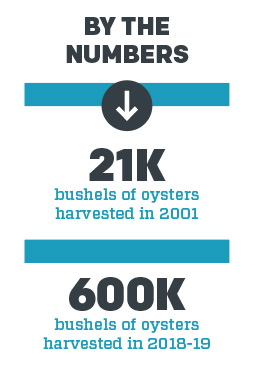
The number of oysters harvested in the Chesapeake Bay has grown wildly in the last two decades.
Perhaps the most satisfying thing for the cousins has been the ability to provide an opportunity to work, grow, and live in what has been a depressed rural economy. “Too often, rural communities such as ours lose promising talent as people look elsewhere due to lack of opportunity,” said Croxton. “We’re proud that our employees have a reason to stay.”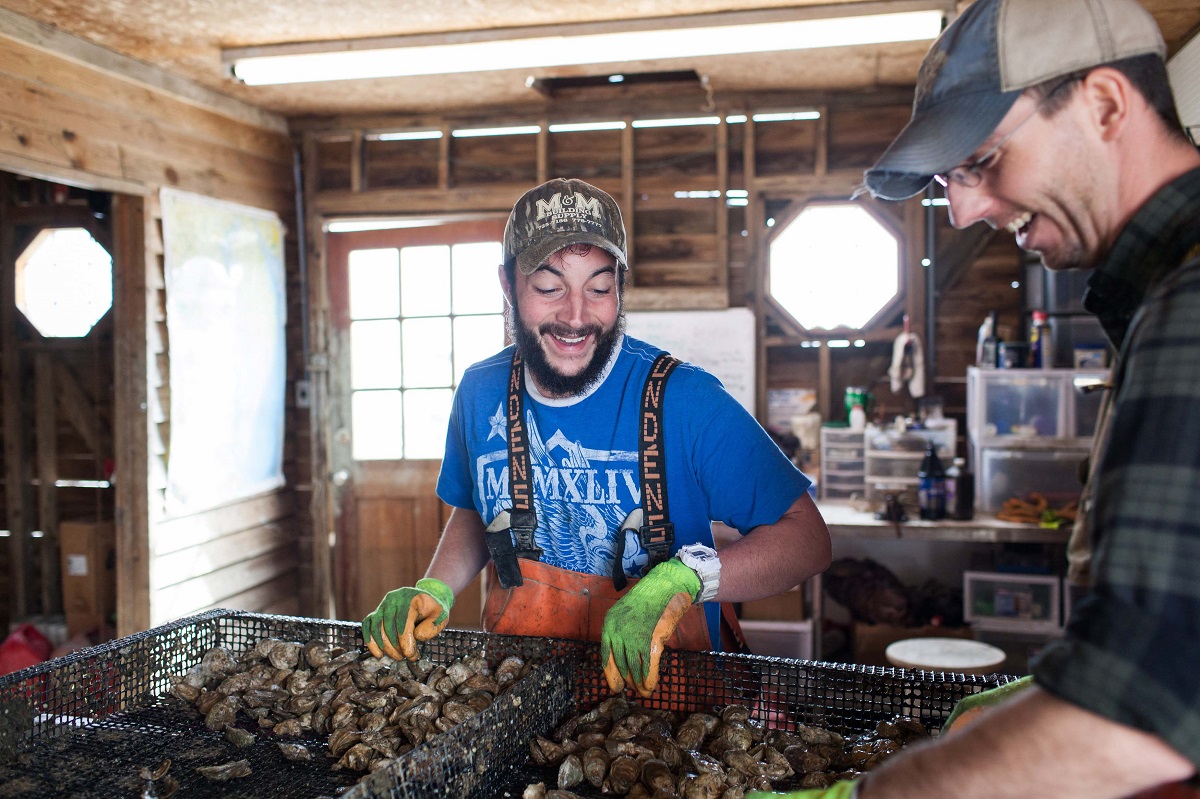
Photo courtesy Rappahannock Oyster Co.
By 2004, Rappahannock had developed a thriving wholesale business. Now with their tasting room, Merroir, four stand-alone oyster bars from Washington, DC, to Los Angeles, California, and a restaurant, Rappahannock, in Richmond, Virginia, the cousins are able to share their oysters and their dedication to “good people doing great things.”
When we checked in during spring 2020, owner Travis Croxton didn’t deny that it had been tough for Rappahannock Oyster since the COVID-19 pandemic had hit. He and cousin Ryan Croxton had to furlough hundreds of employees at their oyster company and restaurants. But, as Travis Croxton said, “You have to perform a hard pivot and await what the future may hold.” Rappahannock quickly set up an employee relief fund for those in need and shifted their restaurants to solely curbside pickup/takeout. On the oyster company side, they had to make additional hard pivots, focusing mostly on internet sales (which Travis Croxton said have greatly increased) and designing completely new business models, which included working with vineyards and breweries to sell 25-count bags of their oysters on consignment on weekends. 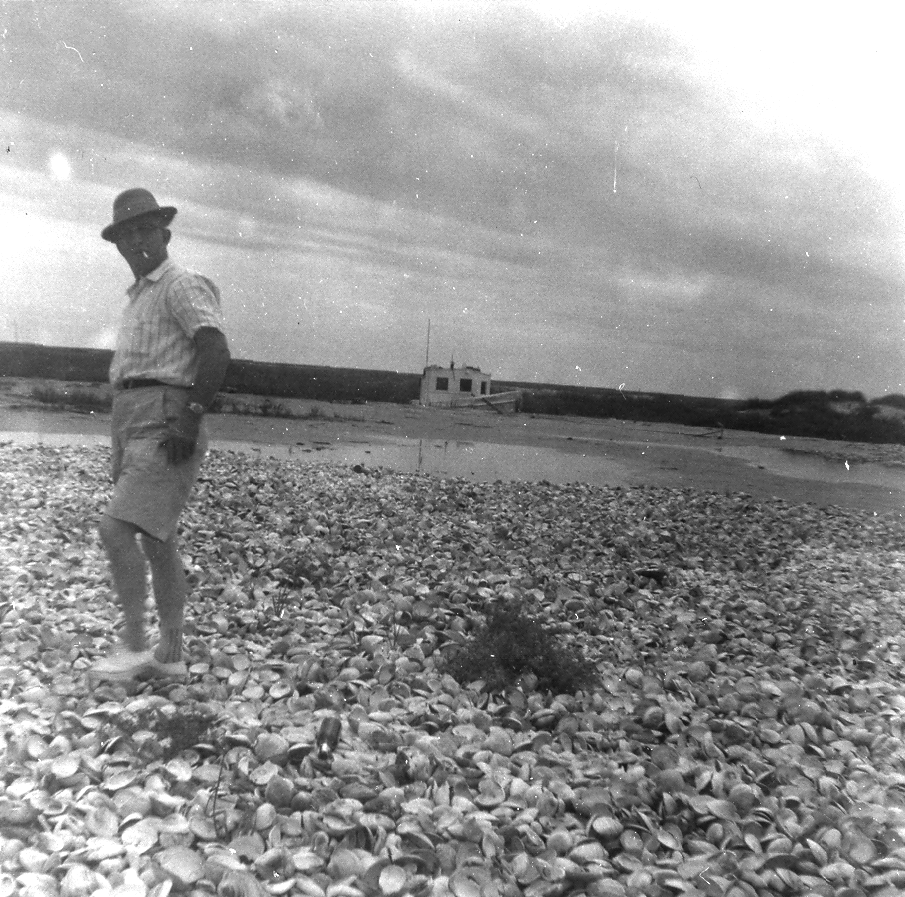
In 1899, James Croxton, great-grandfather of Travis and Ryan Croxton, laid claim to two acres of Rappahannock River bottom for the purpose of growing oysters. / Photo courtesy Rappahannock Oyster Co.
Despite these challenges, by trying to sustain nature, not tame it, the Croxtons have carried on their great-grandfather’s legacy, this time on a foundation of sustainability.
This post is adapted from “Sustainability at Stake,” an article written by Linda Engelsiepen for the June–December 2020 issue of The Henry Ford Magazine.
entrepreneurship, nature, environmentalism, agriculture, farms and farming, food, by Linda Engelsiepen, The Henry Ford Magazine
Great Lakes Brewing Co.: Brewing Good before and during a Pandemic
Great Lakes Brewing Co. has been around for more than 30 years, brewing award-winning craft beer in Cleveland’s Ohio City neighborhood. Its founders, brothers Daniel and Patrick Conway, focused on sustainability from the start by renovating the 19th-century buildings that house their brewery and brewpub.
By the early 2000s, they’d also decided they wanted to do more for their community, the environment, and the health and well-being of their workers. “We view business as a force for good in our communities,” said Daniel Conway. “Our role is essentially one of stewardship.”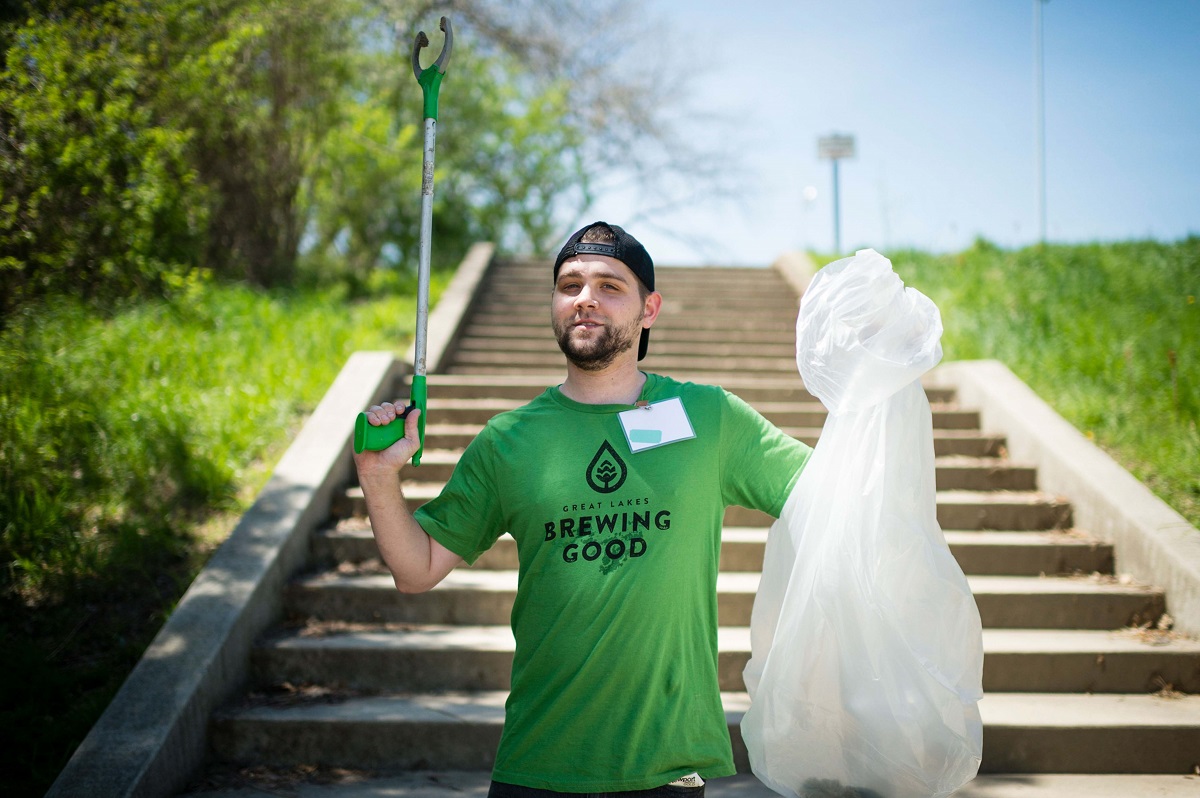
A Brewing Good community clean-up effort by Great Lakes Brewing Co. / Photo courtesy Great Lakes Brewing Co.
The brothers have developed a triple bottom line business model that addresses profit, people, and planet, with initiatives that include water stewardship, renewable and clean energy, and inclusive economic growth.
An early adopter in the local food movement, the company established its own farm, Pint Size Farm, in collaboration with Hale Farm and Village in 2008 to supply its brewpub, and in 2010 co-founded Ohio City Farm, one of the largest urban farms in the United States (learn more about these two farms here). The solar panels on their brewery offset 13 tons of carbon dioxide emissions annually—a widget on their website shows how much beer is brewed using solar energy. And by inviting employees to become owners through an employee stock program, the company allows everyone a stake in its sustainability.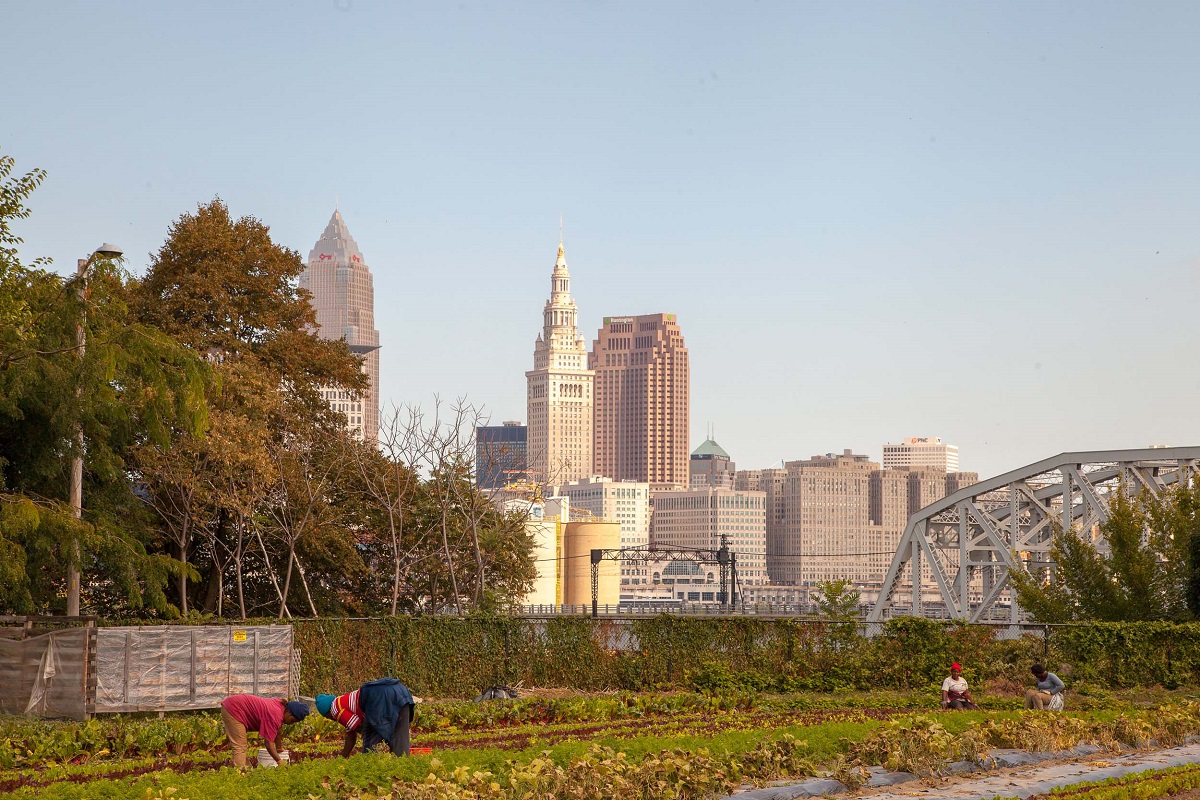
Ohio City Farm, co-founded by Great Lakes Brewing Co. / Photo courtesy Great Lakes Brewing Co.
Great Lakes’ Brewing Good giving program also commits a percentage of company sales back to the community through initiatives that preserve history, advocate environmentalism, and focus on critical needs in the local area. The company’s nonprofit Burning River Foundation, which annually hosts the Great Lakes Burning River Fest, strives to maintain and celebrate the vitality of the region’s freshwater resources. “Burning River,” also the name of a Great Lakes Brewing Co. pale ale, references a particular incident: the Cuyahoga River fire of 1969, in which an oil slick on the heavily polluted river caught fire and caused damage in the six figures. The incident sparked further outrage and interest in environmentalism, driving significant policy changes for the Cleveland area and beyond.
While the COVID-19 pandemic forced Great Lakes Brewing Co. to close its brewpub temporarily, beer continued to be brewed and to flow through the local distribution footprint and to-go service. Beers such as the 107 IPA and Siren Shores Passion Fruit Saison, the first employee team recipe ever created on Great Lakes Brewing’s Small Batch Pilot System, debuted in spring 2020. Social media channels continued to keep the community in the know on what Great Lakes was up to, from its Hop College going online and posting video tutorials and sessions on Facebook, to owner Daniel Conway’s heartfelt request to join him in supporting the Race for Relief fundraiser benefiting the Society of St. Vincent de Paul Cleveland hunger centers.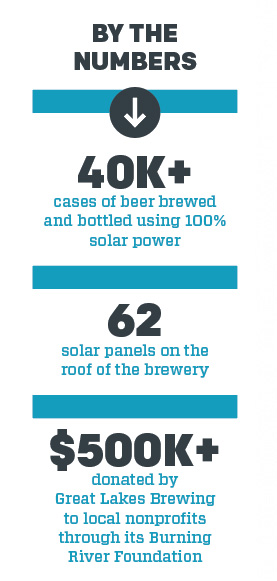
Statistics on Great Lakes Brewing Co.’s sustainability efforts as of mid-2020.
The Conway brothers have long had an understanding of how each part of their business ecosystem feeds into the next. By continuing to innovate new strategies of sustainability, they’ve led by example and helped to revive both an industry and their community.
This post is adapted from “Sustainability at Stake,” an article written by Linda Engelsiepen for the June–December 2020 issue of The Henry Ford Magazine.
entrepreneurship, COVID 19 impact, farms and farming, food, by Linda Engelsiepen, The Henry Ford Magazine, environmentalism, beverages
Honoring Rachel Carson’s Legacy with Citizen Science
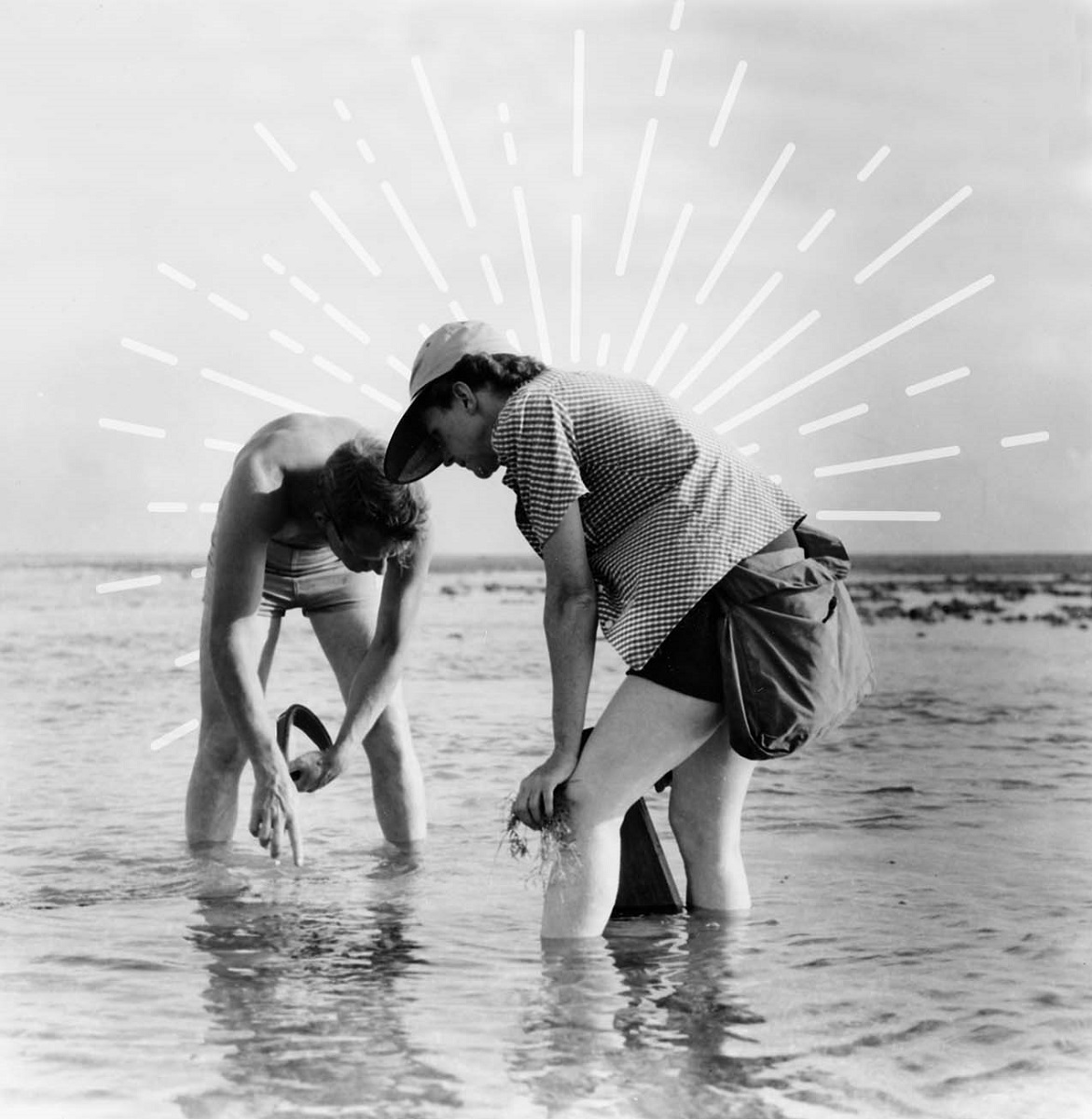
Trained scientist Rachel Carson and wildlife artist Bob Hines conduct research off the Atlantic coast in the early 1950s. The two formed an extraordinary partnership, which brought awareness of nature and conservation to the forefront. / Photo courtesy U.S. Fish and Wildlife Service / public domain
We live in an era where environmental sustainability, social responsibility, and renewable resources are keywords for how to live our lives and operate our businesses.
But it wasn’t always this way. In the early 1960s, writer and biologist Rachel Carson was one of the lone voices sounding the alarm that the rapid, destructive changes we were making to our own environment were having disastrous consequences.
With her groundbreaking 1962 book Silent Spring, which exposed the damage caused by indiscriminate use of pesticides manufactured by powerful chemical companies, Carson showed that she was a scientist motivated by a sense of responsibility to serve the best interests of the wider community. Carson’s eloquence reminded us that we are all part of a delicately balanced ecosystem, and by destroying any piece of it, we risk destroying the whole system. It would become unsustainable.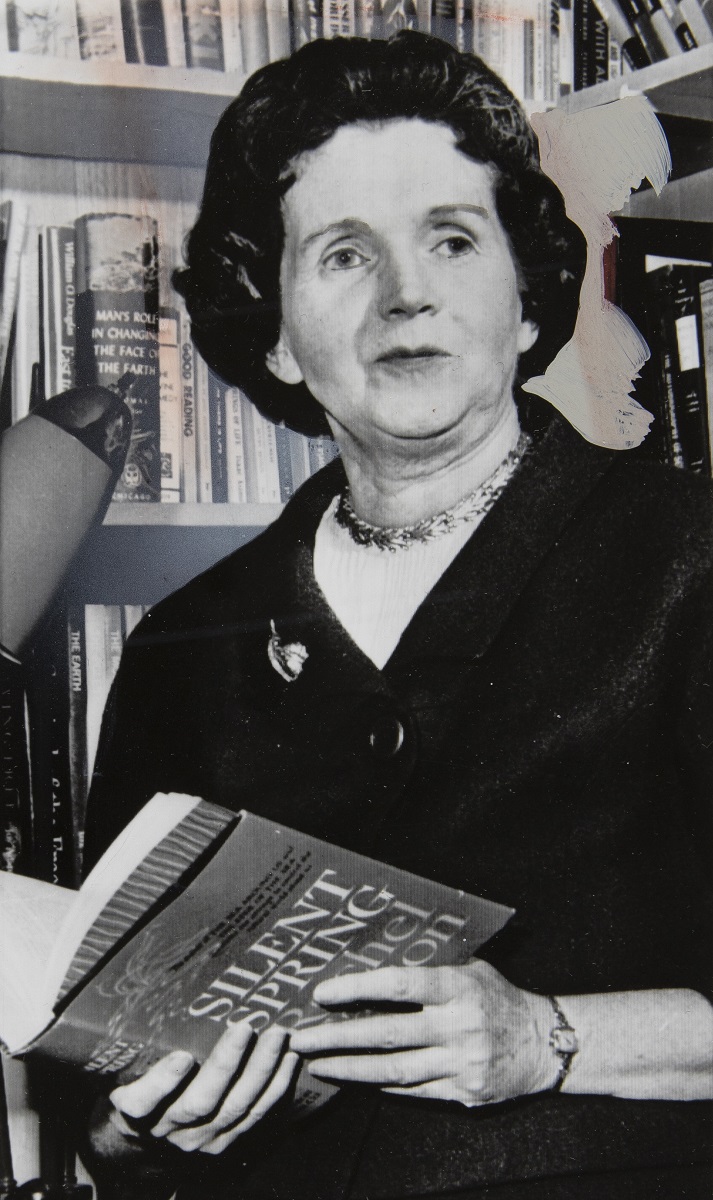
Rachel Carson holding a copy of Silent Spring in June 1963. / THF147928, detail
Thanks to Carson’s passion and perseverance, a movement of ecological awareness was born. Her work is credited with giving birth to the modern-day environmental movement. Other direct results were the banning of the pesticide DDT and the creation of the U.S. Environmental Protection Agency.
In an era of “living better through chemicals,” Rachel Carson was a changemaker who brought our awareness to the effects we had on our environment. But she also knew that we could be part of the solution. One way people carry on her legacy today is by acting as citizen scientists.
While Rachel Carson was a trained scientist and biologist working toward the greater good, a citizen scientist is a nonscientist who works with the scientific community to affect positive change. By paying attention to our environment and taking an interest in the science behind sustainability, we all can make a difference. Here are some ways you can become involved yourself.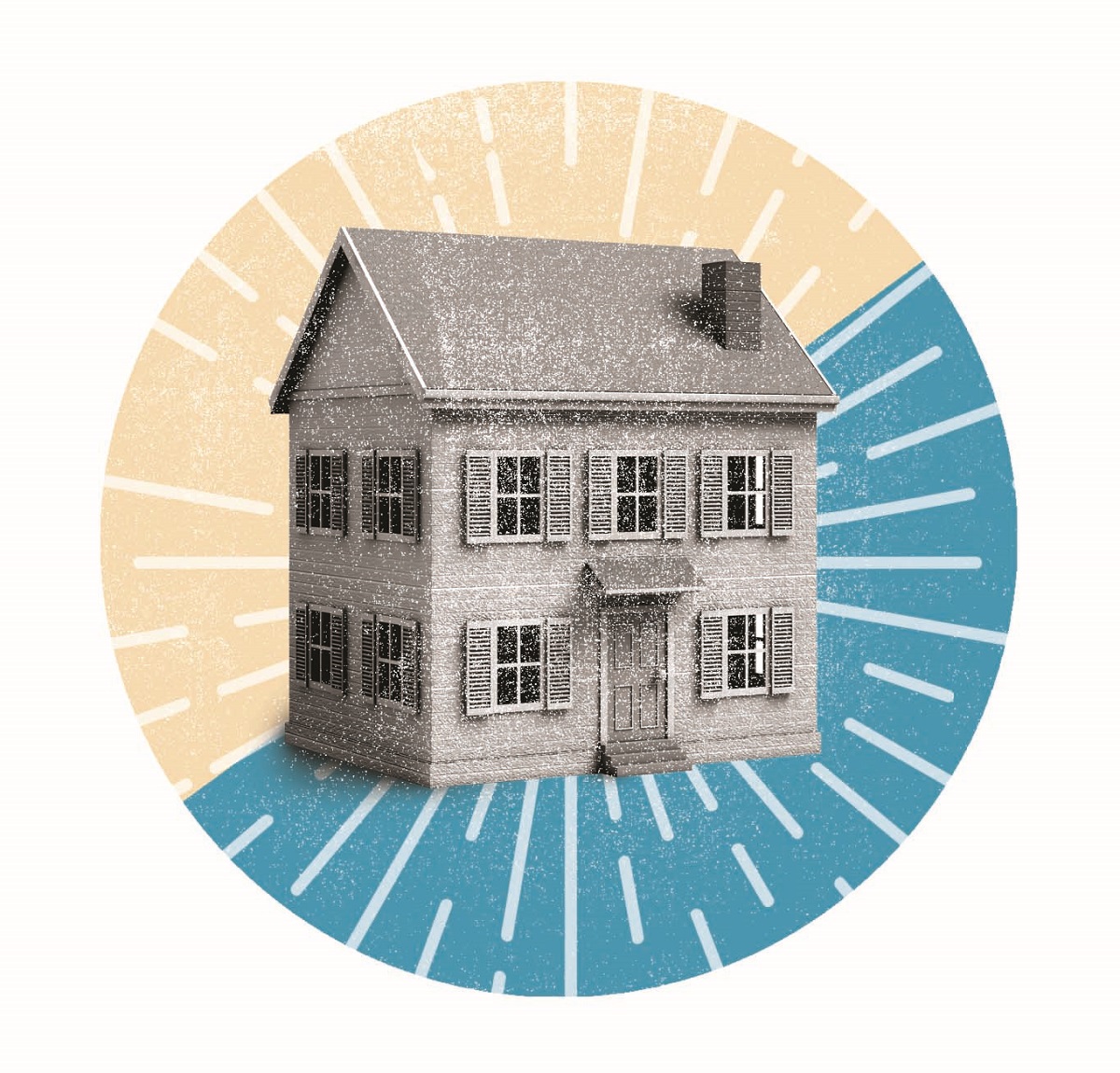
At Home
It was a friend of Rachel Carson who raised an alarm about bird die-offs in her backyard and prompted Carson to write Silent Spring—proof that big change can start small. Here are a couple of ideas worth considering in your sustainability quest at home.
- Join the annual Great Backyard Bird Count at birdcount.org. The count is a great way to get kids involved with nature.
- Use your smartphone to help scientists gather data on animal populations. You can count Costa Rican wildcats at Instant Wild (instantwild.zsl.org) or share observations on your local wildlife at iNaturalist.org.
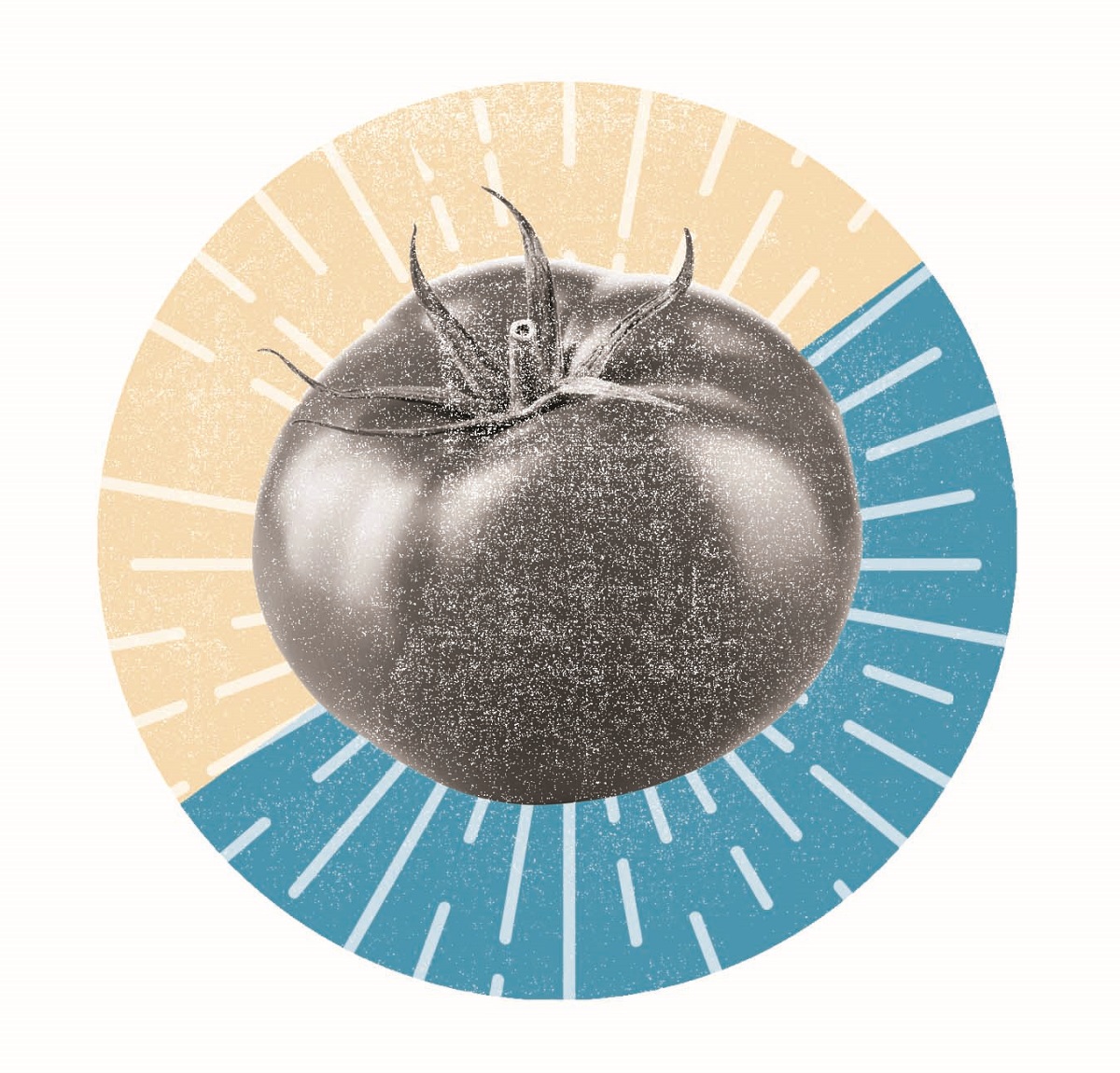
In Your Community
Look for opportunities for neighborhood involvement—you’ll stay socially connected and help your community at the same time.
- Use resources like greenamerica.org to find and support businesses and brands that are striving toward sustainability.
- Start a community garden. It’s a great way to shift away from packaged, processed foods and to get to know your neighbors. National Garden Clubs (gardenclub.org) helps coordinate the interests and activities of state and local garden clubs in the U.S. and abroad.
- Participate in crowdsourced data gathering like noisetube.net, which measures noise pollution, or createlab.org, which trains artificial intelligence to identify smoke emissions.
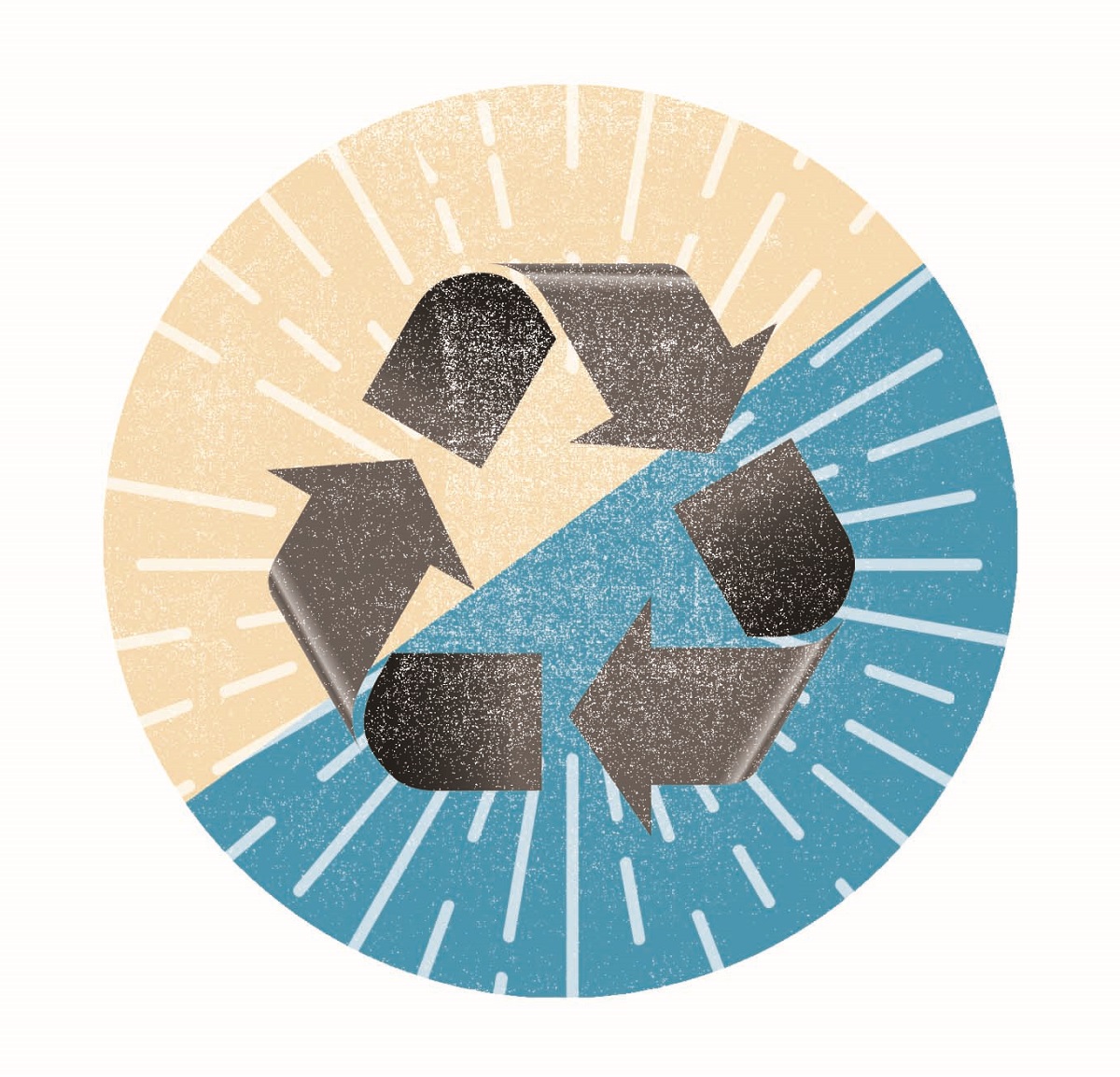
In Your Workplace
If you are motivated to make a difference, become an advocate for sustainability and social change within your company. Going green is a differentiator that gives businesses a leg up on recruiting and marketing.
- Recycle office waste, implement inventory controls (which prevent unnecessary purchases and wasteful spending), or research tax credits for becoming energy efficient at energy.gov, the website of the U.S. Department of Energy.
- Let your company’s unused computing power contribute to scientific research projects at scienceunited.org.
You can find even more inspiration to take action by browsing our website for artifacts related to Rachel Carson, artifacts related to environmentalism, and blog posts related to environmentalism.
This post is adapted from “Sustainability at Stake,” an article written by Linda Engelsiepen for the June–December 2020 issue of The Henry Ford Magazine.
Rachel Carson, women's history, The Henry Ford Magazine, nature, home life, environmentalism, by Linda Engelsiepen
Making the Cut: The Tripp Sawmill
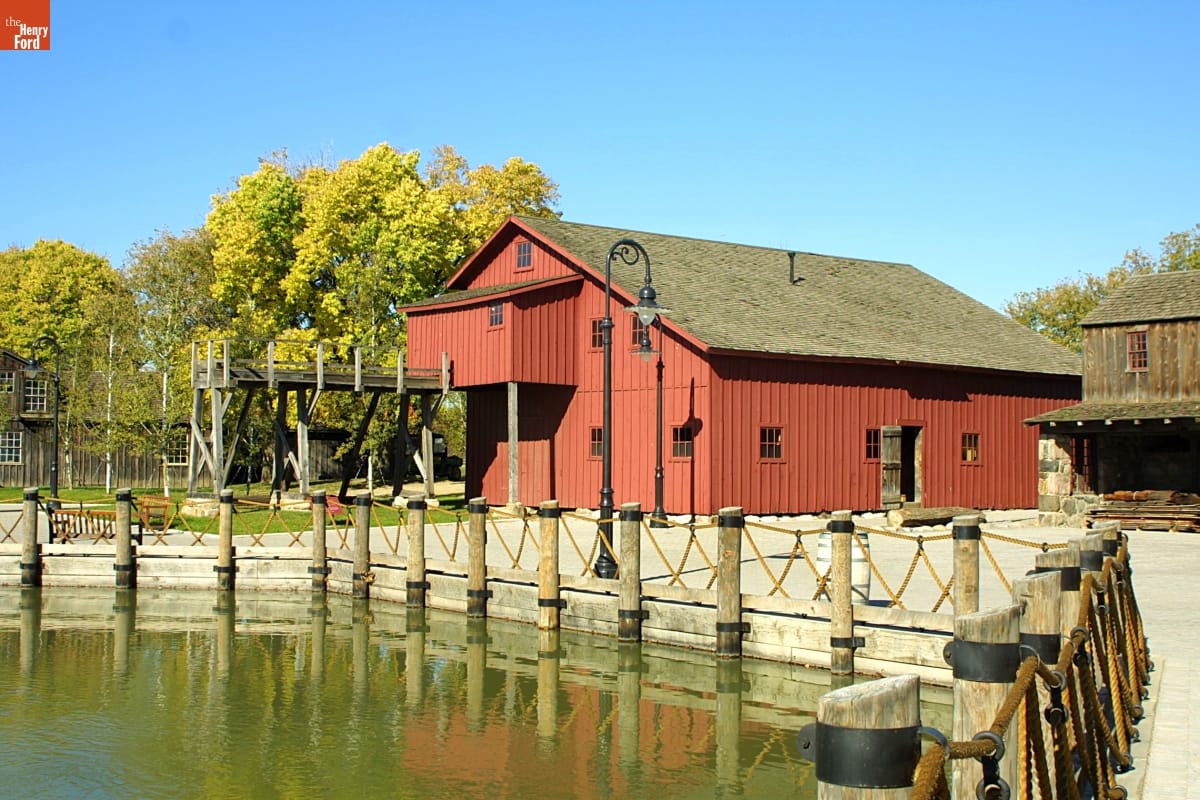
Tripp Sawmill in Greenfield Village. / THF1880
Visit the Liberty Craftworks district in Greenfield Village, and a red structure stands out at the far end of the pond. That’s the Tripp Sawmill, which once operated in Tipton, Michigan, in the mid-1800s, under the ownership of Rev. Henry Tripp and his family.
“It’s an interesting example of a logical, sequential, flowing process,” Marc Greuther, vice president of historical resources and chief curator at The Henry Ford, said of the sawmill. “It’s not a stretch to think of the building as a kind of machine, if you will, a single-purpose machine that is quite refined.”
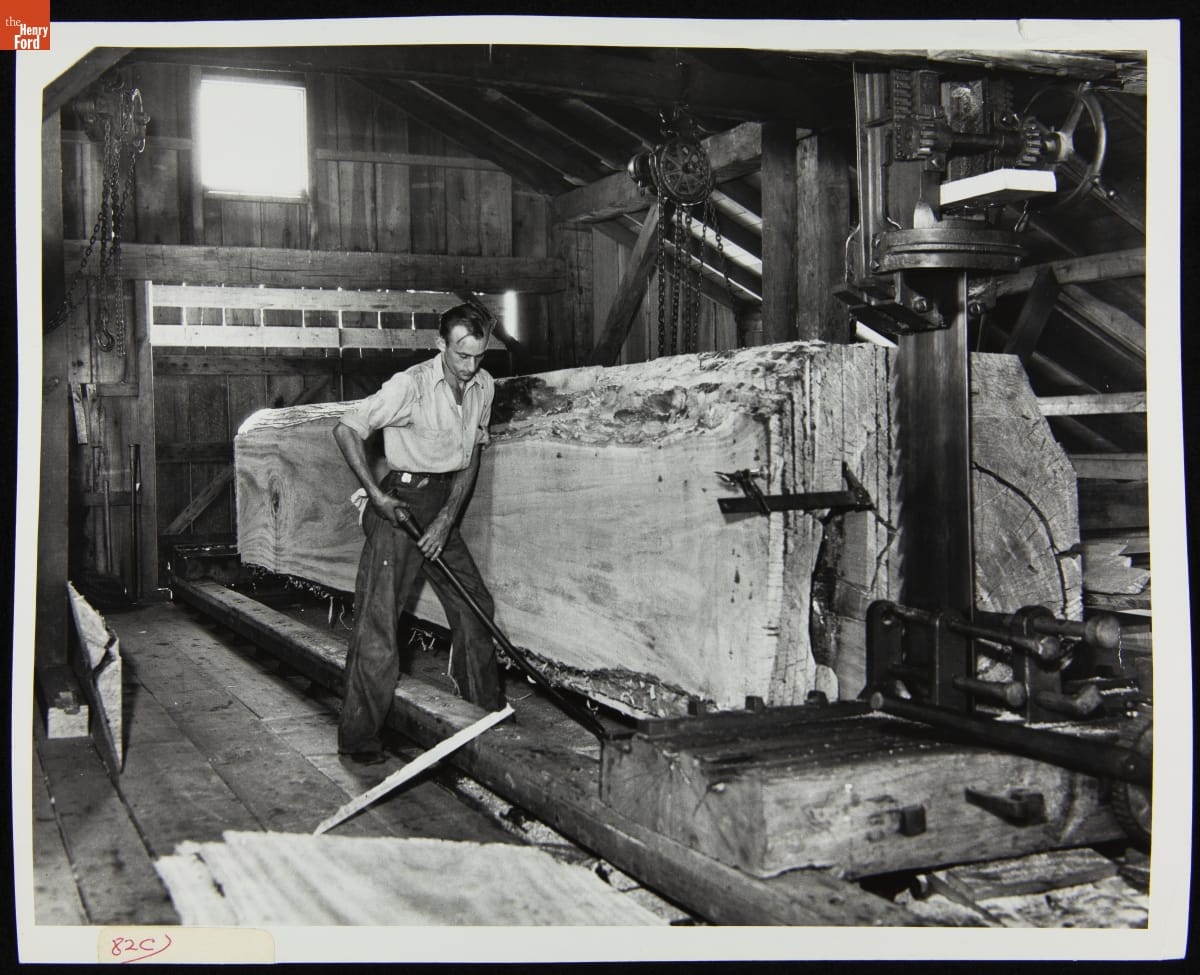
A Man Working in the Tripp Sawmill in Greenfield Village, June 15, 1936. / THF277109
The sawmill was built and run solely by the Tripp family, tailored to the needs of the surrounding community. Tipton, an early American startup of sorts, was not necessarily looking for a large-scale logging operation in its midst. Instead, it needed a self-contained, functioning sawmill that could cut and process lumber from the area’s felled trees. It most likely operated only during the winter months, when residents could easily move felled trees from their properties across the frozen ground. “The Tripps were quite adept at figuring out how to start a business and find a niche,” said Greuther. “They were venturesome, entrepreneurial, and had that can-do attitude.”
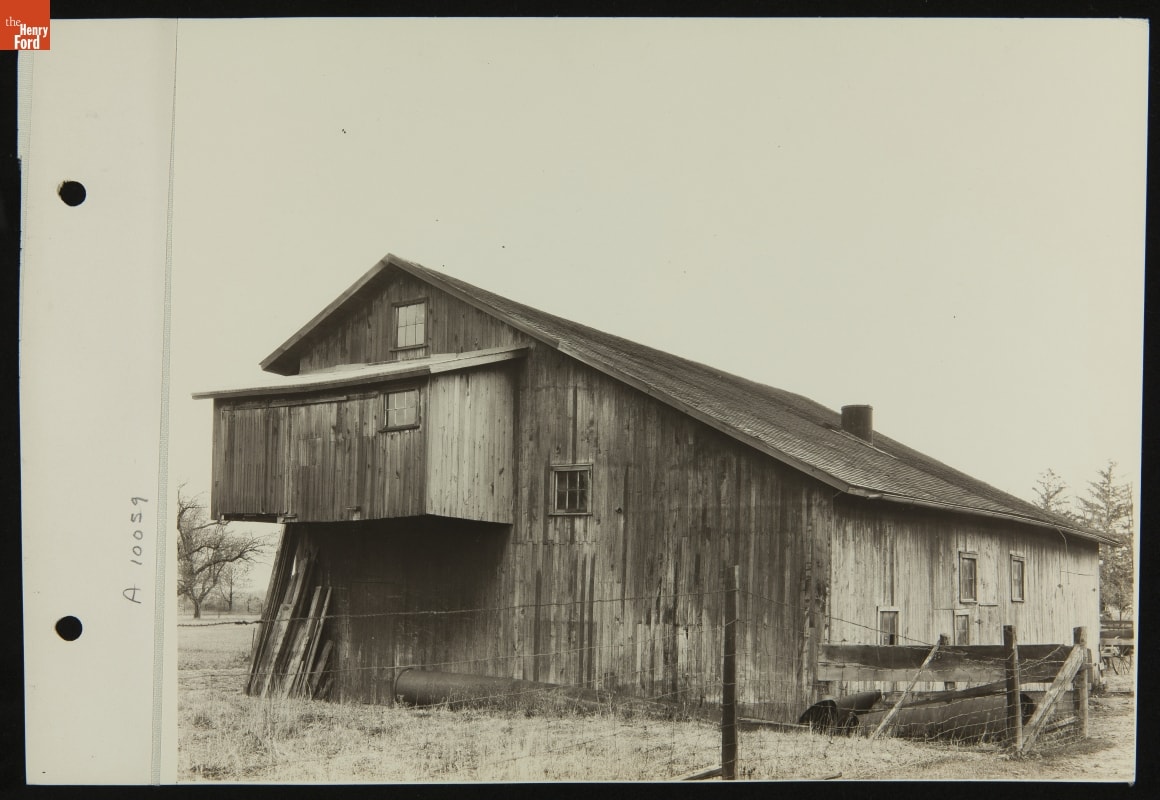
The Tripp Sawmill on its original site in Tipton, Michigan. / THF243590
While many such sawmills in the United States at the time were water-powered, especially those started in newly founded communities, the Tripp Sawmill was powered by steam from the outset—finely tuned and aligned to the resources within its vicinity. A well, for example, was on-site. The mill collected and used rainwater. Its boiler was fueled with waste wood and sawdust from the mill’s operation. “The mill exemplifies a judicious use of resources and technology and human personnel and output all working together,” said Greuther.
Continue Reading
by Jennifer LaForce, The Henry Ford Magazine, Michigan, manufacturing, Greenfield Village buildings, Greenfield Village
How Do Everyday Things Reflect Community?
Everyday objects are more than just things. Ultimately, they are about people—and about community. As humans, we need a sense of belonging—it’s what connects us to each other and to the larger world.
While our individual strengths are important, they are even stronger when joined within a common goal and purpose. Ordinary objects—like a bucket, hardware display, piano, blouse, and computer—might attract little notice. Yet they reflect larger stories of community that engage, unite, and inspire.
Everyday objects. Rich stories.
Fire Bucket, 1803
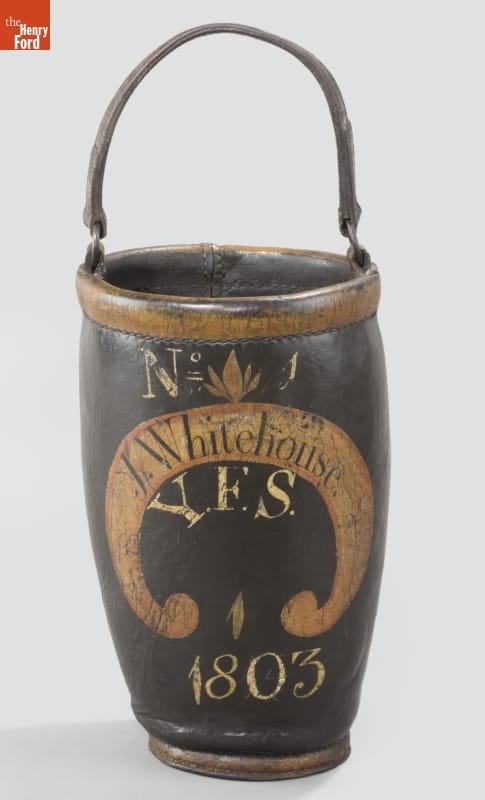
THF166604
Community was once defined by geographic location and close patterns of human interaction—and, as this 1803 fire bucket shows, often involved collective action. In the event of a fire, people formed a bucket brigade to come to each other’s aid.
L. Miller & Son Store Display of Snips, Planes, Plumb Bobs, and Measuring Tools, 1923–1928
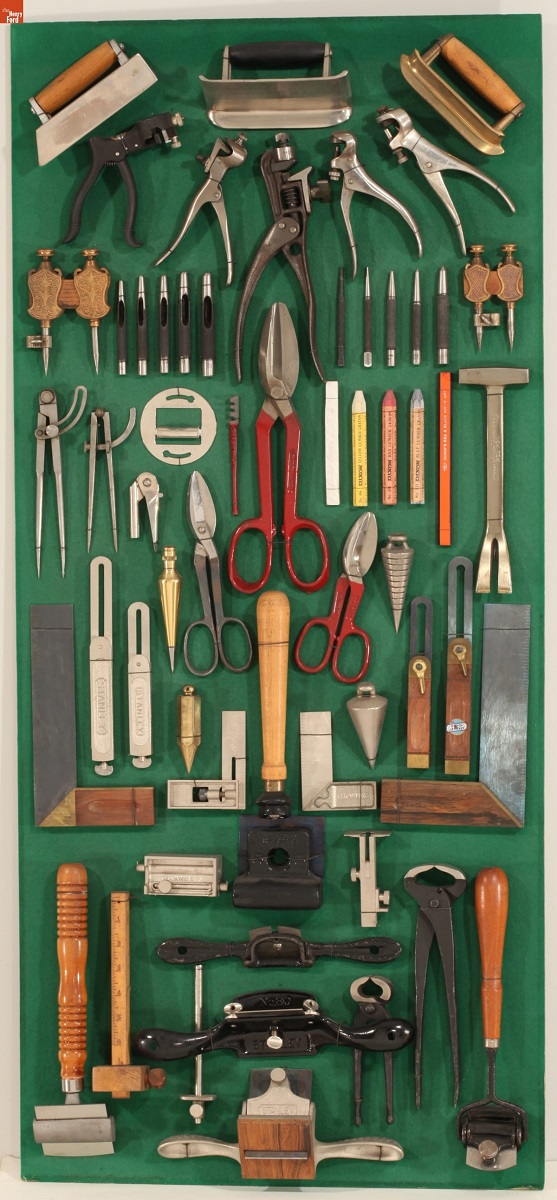
THF150965
Tools and hardware from Louis Miller’s Chicago store provide a lens into an Eastern European immigrant community of the 1920s. To make it easier for customers who did not speak English, Miller showcased his store’s stock in an extensive wall display. His customers simply pointed to the item they wished to buy.
Piano, Used at Club Harlem, Detroit, Michigan, 1934

THF166445
This unassuming little piano belies its jazzy past at Club Harlem in Detroit’s Paradise Valley. Racial discrimination had sequestered the city’s Black population into a tight-knit, vibrant community where Black-owned businesses dotted the streets. Paradise Valley—with its clubs, theaters, and dance halls—became Detroit’s major entertainment spot in the 1930s and 1940s.
Blouse, Made for Farm or Factory Workers During WWII, circa 1943
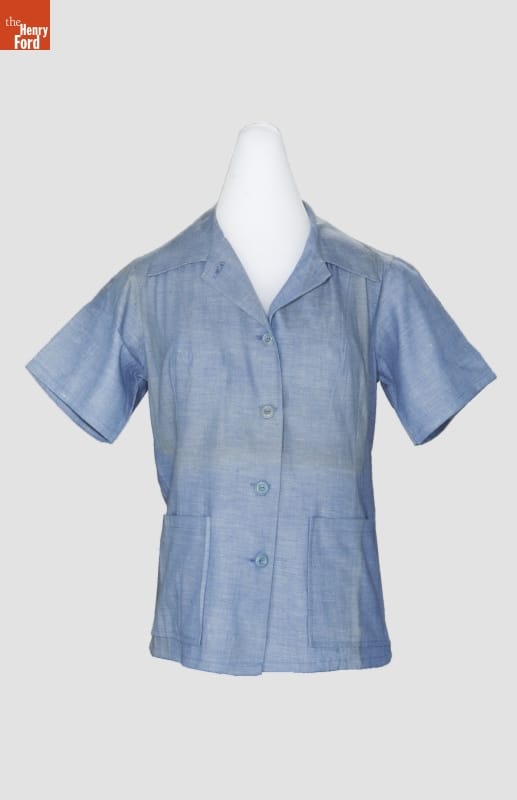
THF173334
This unpretentious work blouse reveals a powerful World War II story of community. As men left to join the military, women heeded the call to “do the job he left behind,” working in factories to produce planes, jeeps, and tanks. They helped win the war.
Google Pixel Slate, 2018–2019
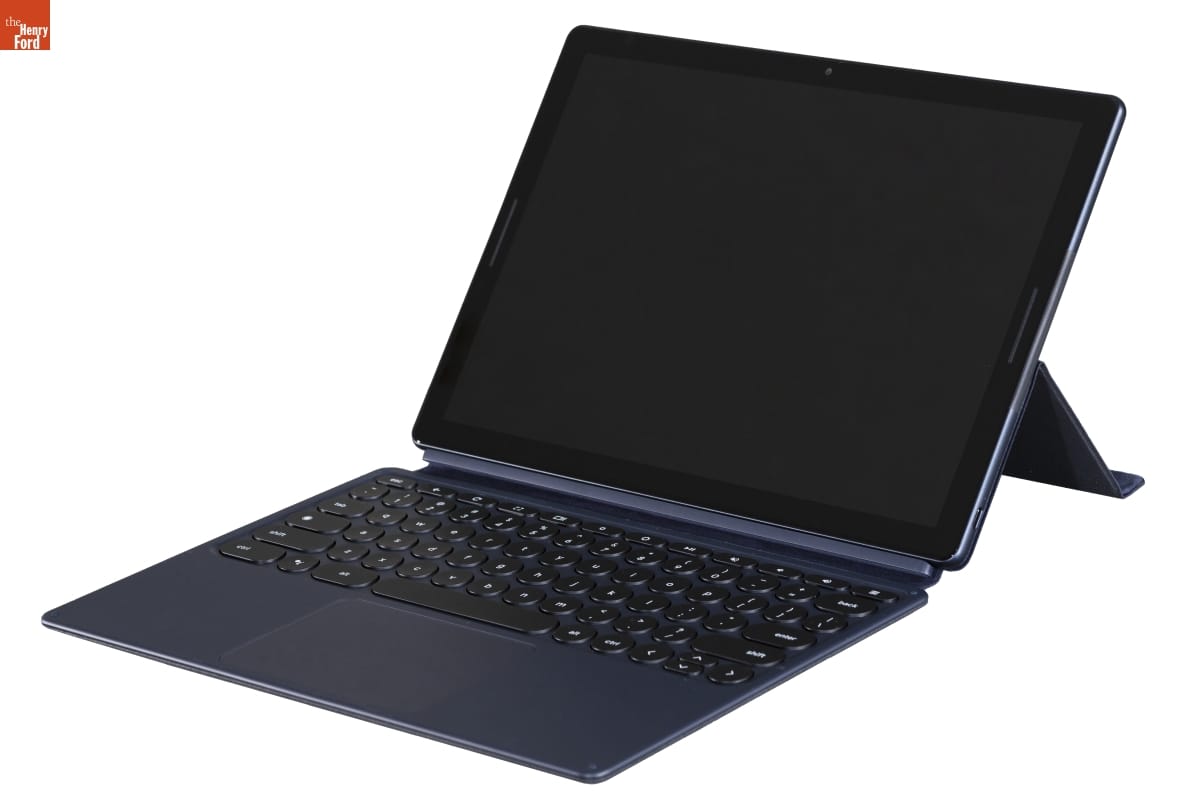
THF185319
Computers and the internet have offered new—and increasingly complex—layers of virtual community. No longer bound by physical proximity, communities form online and cover the globe.
Jeanine Head Miller is Curator of Domestic Life at The Henry Ford. This post was adapted from an article first published in the January–May 2021 issue of The Henry Ford Magazine.
Architect of the Everyday: Designer Michael Graves
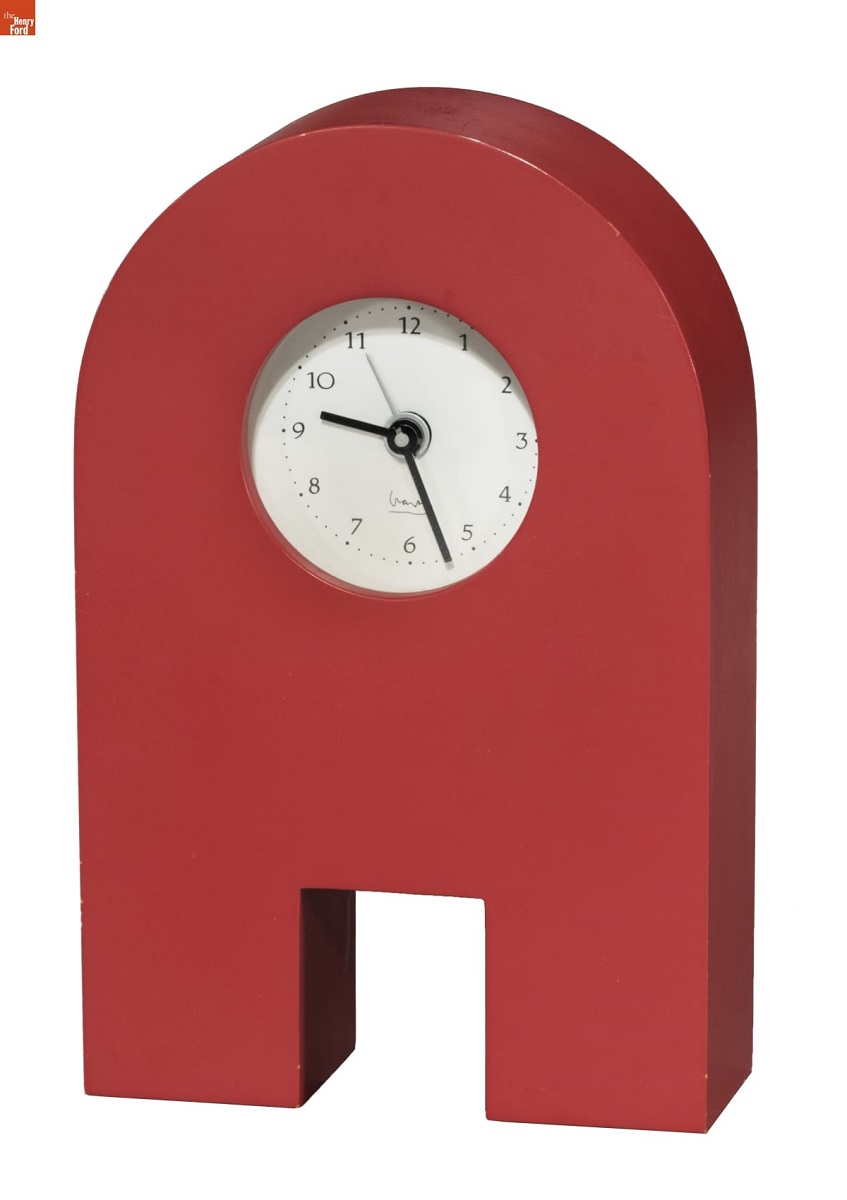
Arch Alarm Clock, Designed by Michael Graves, 1999 / THF179673
In 2019, The Henry Ford acquired Michael Graves Design’s extensive product design archive as part of its permanent collection—more than 2,500 objects in total. The Michael Graves Design archive consists of finished products, models, prototypes, and production samples representing partnerships with Alessi, Target, Stryker, Disney, Steuben, Swid Powell, Sunar, Lenox, Dansk, Duravit, and Dornbracht, among others.
“In its entirety, the Michael Graves Design product archive tells a 39-year history of art, culture, and commerce, along with countless stories about the power of design,” said Patricia Mooradian, president and CEO of The Henry Ford. “We are honored that the team chose The Henry Ford as the location to house this collection that shows that everyday products can be designed with both purpose and playfulness.”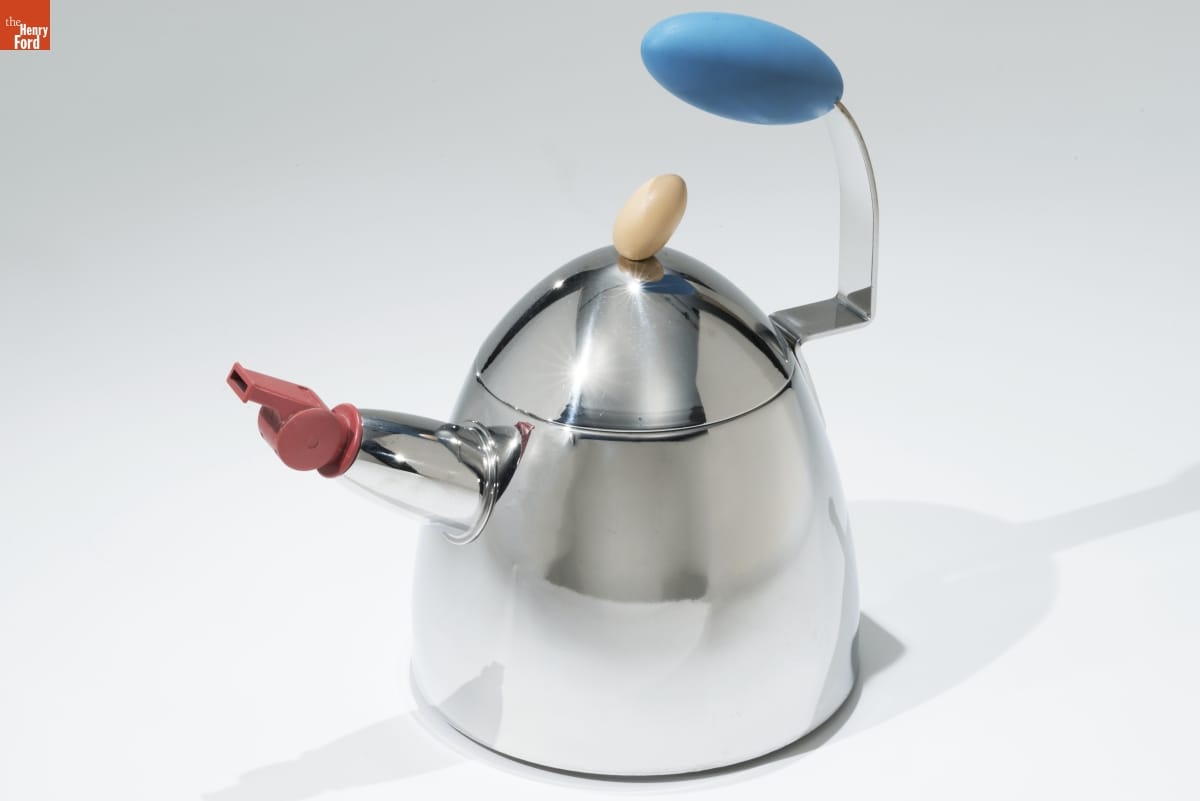
This coach's whistle teakettle was designed by Michael Graves for Target in 1999. / THF179699
Graves’ first designs for Target debuted in 1999. The collaboration eventually brought over 2,000 products to market across 20 categories, including kitchen electrics, gadgets, cleaning supplies, home décor, and storage and organization. This groundbreaking 15-year partnership with Target transformed mass-merchandising strategies, elevated consumers’ expectations for design, and made Target a design destination.
In addition to high-end client relationships, Michael Graves Design’s revolutionary approach to common home products, known as “Art of the Everyday Object,” solidified it as a pioneer in the contemporary design industry.
Toilet brush designed by Michael Graves. / THF179683
“Michael Graves and his designers performed a kind of design alchemy, transforming often humble things—thousands of them—into objects of delight, humor, and elegance,” said Marc Greuther, vice president, historical resources and chief curator at The Henry Ford. “He showed that seeming near-opposites, such as practicality, whimsy, affordability, decoration, and modernity, could actually coexist—and move swiftly off the shelves of everyday retailers.”
Continue Reading
home life, shopping, design, The Henry Ford Magazine, by Jennifer LaForce, Henry Ford Museum

